2013 AMC 10/12 B Discussion
Go back to the Math Jam ArchiveA discussion of problems from the AMC 10/12 B, which is administered February 20. We will cover the last 5 problems on each test, as well as requested earlier problems on the tests.
Copyright © 2025 AoPS Incorporated. This page is copyrighted material. You can view and print this page for your own use, but you cannot share the contents of this file with others.
Facilitator: Jeremy Copeland
copeland
2013-02-21 18:58:16
The Math Jam will start at 7:30 PM Eastern / 4:30 PM Pacific.
The Math Jam will start at 7:30 PM Eastern / 4:30 PM Pacific.
copeland
2013-02-21 18:58:21
The classroom is moderated, meaning that you can type into the classroom, but these comments will not go directly into the room.
The classroom is moderated, meaning that you can type into the classroom, but these comments will not go directly into the room.
copeland
2013-02-21 18:58:36
Please do not ask about administrative aspects of the contests, and please do not ask me to speculate about the results.
Please do not ask about administrative aspects of the contests, and please do not ask me to speculate about the results.
ic1999
2013-02-21 19:24:45
Are we starting with the AMC 10?
Are we starting with the AMC 10?
copeland
2013-02-21 19:24:55
We'll start at AMC10B, Problem 21.
We'll start at AMC10B, Problem 21.
1ph0ne
2013-02-21 19:25:35
Will we only to probs 21+?
Will we only to probs 21+?
copeland
2013-02-21 19:25:36
Probably, unless we have a lot of time at the end, but I'm pretty slow and that usually doesn't happen.
Probably, unless we have a lot of time at the end, but I'm pretty slow and that usually doesn't happen.
Super
2013-02-21 19:25:58
Can we request problems afterward
Can we request problems afterward
copeland
2013-02-21 19:25:59
If there's time.
If there's time.
NextEinstein
2013-02-21 19:27:01
These were some very nice problems
These were some very nice problems
copeland
2013-02-21 19:27:04
I liked a lot of them.
I liked a lot of them.
wcao9311
2013-02-21 19:27:30
when are the questions posted/
when are the questions posted/
copeland
2013-02-21 19:27:31
You can find all the problems as well as discussions of them on our message boards:
You can find all the problems as well as discussions of them on our message boards:
FrozenFury
2013-02-21 19:28:47
Will there be a transcript afterwards?
Will there be a transcript afterwards?
copeland
2013-02-21 19:29:02
Yes. You can find the transcript here later:
http://www.artofproblemsolving.com/School/mathjams.php
Yes. You can find the transcript here later:
http://www.artofproblemsolving.com/School/mathjams.php
copeland
2013-02-21 19:29:31
Oh, and I'm not going to speculate on the cutoff.
Oh, and I'm not going to speculate on the cutoff.
copeland
2013-02-21 19:29:40
Because I have no idea.
Because I have no idea.
mathmaster2012
2013-02-21 19:29:51
Last math jam was very long. Good luck today.
Last math jam was very long. Good luck today.
copeland
2013-02-21 19:29:53
Thanks.
Thanks.
copeland
2013-02-21 19:30:22
Dave's faster than I am, but I got 9 problems instead of 10.
Dave's faster than I am, but I got 9 problems instead of 10.
Archimedes10
2013-02-21 19:30:35
YAAY! IT'S MATH TIME!!!!!!!!
YAAY! IT'S MATH TIME!!!!!!!!
copeland
2013-02-21 19:30:40
Welcome to the 2013 AMC 10B/12B Math Jam!
Welcome to the 2013 AMC 10B/12B Math Jam!
copeland
2013-02-21 19:30:44
I'm Jeremy Copeland, and I'll be leading our discussion tonight.
I'm Jeremy Copeland, and I'll be leading our discussion tonight.
copeland
2013-02-21 19:30:49
Before we get started I would like to take a moment to explain our virtual classroom procedures to those who have not previously participated in a Math Jam or one of our online classes.
Before we get started I would like to take a moment to explain our virtual classroom procedures to those who have not previously participated in a Math Jam or one of our online classes.
copeland
2013-02-21 19:30:55
The classroom is moderated, meaning that students can type into the classroom, but these comments will not go directly into the room. These comments go to the instructors, who may choose to share your comments with the room.
The classroom is moderated, meaning that students can type into the classroom, but these comments will not go directly into the room. These comments go to the instructors, who may choose to share your comments with the room.
copeland
2013-02-21 19:31:02
This helps keep the class organized and on track. This also means that only well-written comments will be dropped into the classroom, so please take time writing responses that are complete and easy to read.
This helps keep the class organized and on track. This also means that only well-written comments will be dropped into the classroom, so please take time writing responses that are complete and easy to read.
copeland
2013-02-21 19:31:11
There are a lot of students here! As I said, only (a fraction of the) well-written comments will be passed to the entire group. Please do not take it personally if your comments do not get posted, and please do not complain about it. I expect this Math Jam to be much larger than our typical class, so please be patient with me---there are quite a few of you here tonight!!
There are a lot of students here! As I said, only (a fraction of the) well-written comments will be passed to the entire group. Please do not take it personally if your comments do not get posted, and please do not complain about it. I expect this Math Jam to be much larger than our typical class, so please be patient with me---there are quite a few of you here tonight!!
copeland
2013-02-21 19:32:04
Also, we won't be going through the math quite as thoroughly as we do in our classes -- I can't teach all the prerequisite material for every problem as we go. Another difference between tonight and our regular online classes is that it is very unlikely that we'll be able to answer every single question you ask. We usually do in our classes, but we have a large number of students tonight! So, please go ahead and ask questions, but also please understand if we aren't able to answer them all!
Also, we won't be going through the math quite as thoroughly as we do in our classes -- I can't teach all the prerequisite material for every problem as we go. Another difference between tonight and our regular online classes is that it is very unlikely that we'll be able to answer every single question you ask. We usually do in our classes, but we have a large number of students tonight! So, please go ahead and ask questions, but also please understand if we aren't able to answer them all!
copeland
2013-02-21 19:32:21
Our main assistant tonight is Rachel Kulikoff.
Our main assistant tonight is Rachel Kulikoff.
copeland
2013-02-21 19:32:23
Rachel Kulikoff is currently a second-year student at the University
of Chicago. She has a wide variety of interests, including
science/math, policy, and education, and has yet to find a major (or
potential career) that combines these interests. Rachel was a
late-comer to mathematical contests, but she did place in the top 40
at the University of Georgia high school math tournament and had the
privilege of competing in the Math Prize for Girls Competition in
2010. Rachel was on the executive board of The Triple Helix, an
interdisciplinary undergraduate research magazine, on house council
(sort of like a Prefect in Harry Potter), and hopes to join the club
water polo team this year. In her dwindled free time, Rachel loves to
swim, think, experiment, and hike.
Rachel Kulikoff is currently a second-year student at the University
of Chicago. She has a wide variety of interests, including
science/math, policy, and education, and has yet to find a major (or
potential career) that combines these interests. Rachel was a
late-comer to mathematical contests, but she did place in the top 40
at the University of Georgia high school math tournament and had the
privilege of competing in the Math Prize for Girls Competition in
2010. Rachel was on the executive board of The Triple Helix, an
interdisciplinary undergraduate research magazine, on house council
(sort of like a Prefect in Harry Potter), and hopes to join the club
water polo team this year. In her dwindled free time, Rachel loves to
swim, think, experiment, and hike.
AdmireEuler
2013-02-21 19:32:27
hey guys!
hey guys!
Andrew
2013-02-21 19:32:48
Hello!
Hello!
planetpeter91
2013-02-21 19:32:48
hello
hello
jeremylu
2013-02-21 19:32:48
hi Rachel Kulikoff.
hi Rachel Kulikoff.
distortedwalrus
2013-02-21 19:32:48
hello
hello
french01math
2013-02-21 19:32:48
hello
hello
flyrain
2013-02-21 19:32:48
hi
hi
smart99
2013-02-21 19:32:48
hi
hi
NathanV
2013-02-21 19:32:48
Hi!
Hi!
copeland
2013-02-21 19:33:05
Rachel can answer questions by whispering to you or by opening a window with you to chat 1-on-1. However, due to the large size of the session tonight, she may not be able to get to you right away (or at all). Repeating your question over and over is more likely to annoy us than to get it answered faster, so please, just ask your question once and be patient, and please understand that we may not be able to answer all the questions tonight.
Rachel can answer questions by whispering to you or by opening a window with you to chat 1-on-1. However, due to the large size of the session tonight, she may not be able to get to you right away (or at all). Repeating your question over and over is more likely to annoy us than to get it answered faster, so please, just ask your question once and be patient, and please understand that we may not be able to answer all the questions tonight.
copeland
2013-02-21 19:33:08
Please also remember that the purpose of this Math Jam is to work through the solutions to AMC problems, and not to merely present the answers. "Working through the solutions" includes discussing problem-solving tactics. So please, when a question is posted, do not simply respond with the final answer. That's not why we're here. We're going to work through the problems step-by-step, and comments that skip key steps or jump ahead in the problem, without providing explanation or motivation, won't be posted.
Please also remember that the purpose of this Math Jam is to work through the solutions to AMC problems, and not to merely present the answers. "Working through the solutions" includes discussing problem-solving tactics. So please, when a question is posted, do not simply respond with the final answer. That's not why we're here. We're going to work through the problems step-by-step, and comments that skip key steps or jump ahead in the problem, without providing explanation or motivation, won't be posted.
copeland
2013-02-21 19:33:21
We will work the last 5 problems from the AMC 10B, then the last 5 problems from the AMC 12B. Two of these problems are the same, 10A Problem 25 and 12A Problem 23. We'll only solve that problem once.
We will work the last 5 problems from the AMC 10B, then the last 5 problems from the AMC 12B. Two of these problems are the same, 10A Problem 25 and 12A Problem 23. We'll only solve that problem once.
copeland
2013-02-21 19:33:31
Oh, and there's a half a bajillion folks here tonight. It hurts me to say it, but we're probably going to miss some of the things that some of you say. (Especially during the geometry problems - sheesh.) Please forgive me in advance. That doesn't happen in our classes.
Oh, and there's a half a bajillion folks here tonight. It hurts me to say it, but we're probably going to miss some of the things that some of you say. (Especially during the geometry problems - sheesh.) Please forgive me in advance. That doesn't happen in our classes.
copeland
2013-02-21 19:33:43
Ready to get started?
Ready to get started?
medianpi
2013-02-21 19:33:56
yes
yes
Lord.of.AMC
2013-02-21 19:33:56
YES
YES
coldsummer
2013-02-21 19:33:56
yes
yes
fcc1234
2013-02-21 19:33:56
yeah!!!
yeah!!!
JigglykongisFUM16
2013-02-21 19:33:56
Sure
Sure
abhishek26
2013-02-21 19:33:56
sure
sure
OISHIKA_DAS
2013-02-21 19:33:56
Yes
Yes
kdokmeci
2013-02-21 19:33:56
Yes!
Yes!
lakshmi_leo
2013-02-21 19:33:56
yup
yup
iRezizt
2013-02-21 19:33:56
yes!
yes!
djmathman
2013-02-21 19:33:56
Let's go!
Let's go!
wcao9311
2013-02-21 19:33:56
Yes!!
Yes!!
AbsoluteFriend
2013-02-21 19:33:56
yess!!
yess!!
swe1
2013-02-21 19:33:56
Yes
Yes
Archimedes10
2013-02-21 19:33:56
YES!!!!!!!!!!!!
YES!!!!!!!!!!!!
sparkles257
2013-02-21 19:33:56
yes
yes
distortedwalrus
2013-02-21 19:33:56
yes.
yes.
vinayak-kumar
2013-02-21 19:33:56
YEA
YEA
alquila
2013-02-21 19:33:56
YES!!!
YES!!!
a1pha
2013-02-21 19:33:56
Yes
Yes
Andrew
2013-02-21 19:33:56
Yes!
Yes!
DavidLiu729
2013-02-21 19:33:56
yes
yes
JFC
2013-02-21 19:33:56
Yeah!
Yeah!
theone142857
2013-02-21 19:33:56
yes
yes
gaberen
2013-02-21 19:33:56
LETS GOOOOO
LETS GOOOOO
bobthesmartypants
2013-02-21 19:33:56
yes!
yes!
VietaFan
2013-02-21 19:33:56
yes, I am
yes, I am
henrikjb
2013-02-21 19:33:56
yes sir
yes sir
smart99
2013-02-21 19:33:56
yes
yes
mathman500
2013-02-21 19:33:56
Yes!
Yes!
ProblemSolver1026
2013-02-21 19:33:56
yup
yup
dardarmath
2013-02-21 19:33:56
YES!
YES!
planetpeter91
2013-02-21 19:33:56
yup
yup
copeland
2013-02-21 19:34:05


copeland
2013-02-21 19:34:13
Not a bad problem to kick things off. How should we start?
Not a bad problem to kick things off. How should we start?
NextEinstein
2013-02-21 19:35:01
Have one sequence start a, b and the other start c, d
Have one sequence start a, b and the other start c, d
RotomPlasma
2013-02-21 19:35:01
Express the seventh term in terms of the first term (a) and second term (b)
Express the seventh term in terms of the first term (a) and second term (b)
Hydroxide
2013-02-21 19:35:01
let the sequences start with a, b and x, y
let the sequences start with a, b and x, y
PERFECTION
2013-02-21 19:35:01
Start by assigning variables to the first and second terms
Start by assigning variables to the first and second terms
distortedwalrus
2013-02-21 19:35:01
call the first two terms of each sequence a, b and c, d
call the first two terms of each sequence a, b and c, d
theone142857
2013-02-21 19:35:01
Set up variables
Set up variables
j2002
2013-02-21 19:35:01
a, b, a +b...
a, b, a +b...
i8sumpi
2013-02-21 19:35:01
Second sequence first two terms: y1 y2
Second sequence first two terms: y1 y2
centralbs
2013-02-21 19:35:01
Let the first two terms of one sequence be a and b and find an expression for the 7th term
Let the first two terms of one sequence be a and b and find an expression for the 7th term
copeland
2013-02-21 19:35:03
Since the recurrence depends on the previous two terms, every number is determined once you're given the first two numbers. I want to know how the seventh number is related to the first two numbers.
Since the recurrence depends on the previous two terms, every number is determined once you're given the first two numbers. I want to know how the seventh number is related to the first two numbers.
copeland
2013-02-21 19:35:08
If the sequence starts
a,b,…,
what is the seventh term?
If the sequence starts
a,b,…,
what is the seventh term?
guilt
2013-02-21 19:35:39
5a+8b
5a+8b
Voytek
2013-02-21 19:35:39
5a+8b
5a+8b
jiujianxian
2013-02-21 19:35:39
5a+8b
5a+8b
gengkev
2013-02-21 19:35:39
5a+8b
5a+8b
mathwizard888
2013-02-21 19:35:39
5a+8b
5a+8b
RunpengFAILS
2013-02-21 19:35:39
5a+8b
5a+8b
thecmd999
2013-02-21 19:35:39
5a+8b
5a+8b
Sesquipedalian
2013-02-21 19:35:39
5a+8b
5a+8b
dantx5
2013-02-21 19:35:39
5a+8b
5a+8b
copeland
2013-02-21 19:35:42
The sequence continues
a,b,a+b,a+2b,2a+3b,3a+5b,5a+8b,…and the seventh term is 5a+8b. (Notice that the coefficients are Fibonacci numbers!)
The sequence continues
a,b,a+b,a+2b,2a+3b,3a+5b,5a+8b,…and the seventh term is 5a+8b. (Notice that the coefficients are Fibonacci numbers!)
copeland
2013-02-21 19:35:46
Now we have two sequences
a,b,a+b,a+2b,2a+3b,3a+5b,5a+8b,…,and
x,y,x+y,x+2y,2x+3y,3x+5y,5x+8y,…and we also assume that 5a+8b=5x+8y.
Now we have two sequences
a,b,a+b,a+2b,2a+3b,3a+5b,5a+8b,…,and
x,y,x+y,x+2y,2x+3y,3x+5y,5x+8y,…and we also assume that 5a+8b=5x+8y.
copeland
2013-02-21 19:36:02
What can we do with such an equation?
What can we do with such an equation?
centralbs
2013-02-21 19:36:31
Group the multiples of 5 on one side and the multiples of 8 on the other
Group the multiples of 5 on one side and the multiples of 8 on the other
Hydroxide
2013-02-21 19:36:31
Rearrange to get 5(a-x)=8(y-b)
Rearrange to get 5(a-x)=8(y-b)
lazorpenguin27143
2013-02-21 19:36:31
move terms and factor
move terms and factor
Seedleaf
2013-02-21 19:36:31
5(a-x) = 8(y-b)
5(a-x) = 8(y-b)
Aequilipse
2013-02-21 19:36:31
move the numbers with 5 coeffs to one side and 8 coeffs to the other side
move the numbers with 5 coeffs to one side and 8 coeffs to the other side
mbt123
2013-02-21 19:36:31
factor on both sides, 5(a-x)=8(y-b)
factor on both sides, 5(a-x)=8(y-b)
bookie331
2013-02-21 19:36:31
subtract 5x and 8b
subtract 5x and 8b
copeland
2013-02-21 19:36:34
Let's isolate the multiples of 5 and the multiples 8 to get 5(a−x)=8(y−b).
Let's isolate the multiples of 5 and the multiples 8 to get 5(a−x)=8(y−b).
copeland
2013-02-21 19:36:37
How's that useful?
How's that useful?
19oshawott98
2013-02-21 19:37:13
a-x is mult of 8
a-x is mult of 8
googol.plex
2013-02-21 19:37:13
a-x is multiple of 8, y-b is multiple of 5
a-x is multiple of 8, y-b is multiple of 5
19oshawott98
2013-02-21 19:37:13
y-b is mult of 5
y-b is mult of 5
joshxiong
2013-02-21 19:37:13
We know that a-x is a multiple of 8 and y-b is a multiple of 5.
We know that a-x is a multiple of 8 and y-b is a multiple of 5.
copeland
2013-02-21 19:37:18
Since those are integers, both sides are multiple of 40. Specifically we can write 5(x−a)=8(b−y)=40k, telling us that
x=a+8ky=b−5k
Since those are integers, both sides are multiple of 40. Specifically we can write 5(x−a)=8(b−y)=40k, telling us that
x=a+8ky=b−5k
copeland
2013-02-21 19:37:25
To get from one such sequence to another, we increase (or decrease) the first term by a multiple of 8 and decrease (or increase) the second term by the corresponding multiple of 5.
To get from one such sequence to another, we increase (or decrease) the first term by a multiple of 8 and decrease (or increase) the second term by the corresponding multiple of 5.
copeland
2013-02-21 19:37:32
If we start with a pair (a,b) where a≤b, then eventually this stepping will give us a first term that is larger than the second term.
If we start with a pair (a,b) where a≤b, then eventually this stepping will give us a first term that is larger than the second term.
copeland
2013-02-21 19:37:35
What are we looking for in this problem?
What are we looking for in this problem?
matholympiad25
2013-02-21 19:37:54
Smallest possible value of N
Smallest possible value of N
mapletree14
2013-02-21 19:37:54
the smallest N
the smallest N
VietaFan
2013-02-21 19:37:54
The smallest possible N
The smallest possible N
klpt
2013-02-21 19:37:54
Smallest possible value of N?
Smallest possible value of N?
thecmd999
2013-02-21 19:37:54
we're trying to minimize N
we're trying to minimize N
copeland
2013-02-21 19:37:57
such that. . . .
such that. . . .
Voytek
2013-02-21 19:38:31
there are two ways to represent it using multiples of 5 and 8
there are two ways to represent it using multiples of 5 and 8
bobthesmartypants
2013-02-21 19:38:31
a not equal to x
a not equal to x
mbt123
2013-02-21 19:38:31
there are two integer solutions to the above equation
there are two integer solutions to the above equation
math-rules
2013-02-21 19:38:31
a is not x and increasing
a is not x and increasing
rafa2be
2013-02-21 19:38:31
It's the same seventh number but different sequence
It's the same seventh number but different sequence
copeland
2013-02-21 19:38:33
We are looking for a pair for which we can make this step at least once. That is, we want a pair (a,b) where a≤b and also where a+8≤b−5,meaning that b≥a+13.
We are looking for a pair for which we can make this step at least once. That is, we want a pair (a,b) where a≤b and also where a+8≤b−5,meaning that b≥a+13.
copeland
2013-02-21 19:38:43
What pair should we try first, and what N do we get?
What pair should we try first, and what N do we get?
jeremylu
2013-02-21 19:39:30
0, and 13
0, and 13
number.sense
2013-02-21 19:39:30
zero and 13
zero and 13
Lord.of.AMC
2013-02-21 19:39:30
b = 13, a = 0, N=104
b = 13, a = 0, N=104
swe1
2013-02-21 19:39:30
(0,13)
(0,13)
numbertheory
2013-02-21 19:39:30
n=104
n=104
anthonyjang
2013-02-21 19:39:30
(0,13) to 104
(0,13) to 104
numbertheory
2013-02-21 19:39:30
a=8 b=8, n=104
a=8 b=8, n=104
sarvottam
2013-02-21 19:39:30
(0,13)
(0,13)
Imsacred
2013-02-21 19:39:30
a=0, b=13, N=104
a=0, b=13, N=104
linpaws
2013-02-21 19:39:30
(0,13)
(0,13)
thecmd999
2013-02-21 19:39:30
(a,b)=(0, 13) ==> N=104
(a,b)=(0, 13) ==> N=104
mprashker
2013-02-21 19:39:30
b = 13, a = 0, N = 104
b = 13, a = 0, N = 104
copeland
2013-02-21 19:39:34
If (a,b)=(0,13), then N=5a+8b=104. Furthermore, we can get from here to the pair (x,y)=(8,8) and again N=5x+8y=104.
If (a,b)=(0,13), then N=5a+8b=104. Furthermore, we can get from here to the pair (x,y)=(8,8) and again N=5x+8y=104.
copeland
2013-02-21 19:39:36
Can we get any smaller answer?
Can we get any smaller answer?
distortedwalrus
2013-02-21 19:40:03
no, because we can't use anything less than 0
no, because we can't use anything less than 0
number.sense
2013-02-21 19:40:03
no, then a would be negative which results in a decreasing sequence
no, then a would be negative which results in a decreasing sequence
Lord.of.AMC
2013-02-21 19:40:03
no, a is non-negative
no, a is non-negative
lakshmi_leo
2013-02-21 19:40:03
it is nonnegative numbers
it is nonnegative numbers
bobthesmartypants
2013-02-21 19:40:03
no because a has to be non-negative
no because a has to be non-negative
mathman98
2013-02-21 19:40:03
no we can't because a has to be nonnegative
no we can't because a has to be nonnegative
copeland
2013-02-21 19:40:07
No. In order to satisfy b≥a+13, we need to have a≥0 and b≥13, and increasing either will increase the seventh term.
No. In order to satisfy b≥a+13, we need to have a≥0 and b≥13, and increasing either will increase the seventh term.
copeland
2013-02-21 19:40:10
So what's the answer?
So what's the answer?
Ty330
2013-02-21 19:40:24


kdokmeci
2013-02-21 19:40:24
104
104
NathanV
2013-02-21 19:40:24
C 104
C 104
sn1per
2013-02-21 19:40:24
C
C
ninjataco
2013-02-21 19:40:24
C 104
C 104
planetpeter91
2013-02-21 19:40:24
C, 104
C, 104
mydogcanpur
2013-02-21 19:40:24
C
C
sparkles257
2013-02-21 19:40:24
104!
104!
dardarmath
2013-02-21 19:40:24
C. 104
C. 104
copeland
2013-02-21 19:40:27
The answer is (C), 104.
The answer is (C), 104.
copeland
2013-02-21 19:40:33
OK, great.
OK, great.
copeland
2013-02-21 19:40:38
Time for more!
Time for more!
copeland
2013-02-21 19:40:42


copeland
2013-02-21 19:40:55
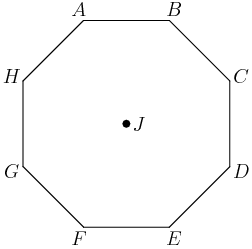

copeland
2013-02-21 19:40:57
What are we trying to find?
What are we trying to find?
sn1per
2013-02-21 19:41:40
its like a magic square sort of
its like a magic square sort of
planetpeter91
2013-02-21 19:41:40
how many ways we can assign numbers 1-9 to points.
how many ways we can assign numbers 1-9 to points.
1ph0ne
2013-02-21 19:41:40
Combinations of number arrangements on octagon.
Combinations of number arrangements on octagon.
Jerry1997
2013-02-21 19:41:40
counting number of ways to make all diagonals through the center equal sum
counting number of ways to make all diagonals through the center equal sum
billgates42
2013-02-21 19:41:40
In how many ways the sums of the numbers are equal
In how many ways the sums of the numbers are equal
PERFECTION
2013-02-21 19:41:40
The ways we can complete this "number puzzle"
The ways we can complete this "number puzzle"
fcc1234
2013-02-21 19:41:40
how many ways you can enter number 1-9 so that AJE is equal to BJF and CJG and DJH
how many ways you can enter number 1-9 so that AJE is equal to BJF and CJG and DJH
jeremylu
2013-02-21 19:41:40
how many ways the vertices, plus J, can be associated with 1 - 9
how many ways the vertices, plus J, can be associated with 1 - 9
copeland
2013-02-21 19:41:44
You might have notice a lack of geometry in this geometry problem. Instead we are just trying to solve a set of equations,a+j+e=b+j+f=c+j+g=d+j+h.Where these are the values associated to the obvious vertices.
You might have notice a lack of geometry in this geometry problem. Instead we are just trying to solve a set of equations,a+j+e=b+j+f=c+j+g=d+j+h.Where these are the values associated to the obvious vertices.
copeland
2013-02-21 19:41:54
Those can probably be simplified. . .
Those can probably be simplified. . .
viperstrike
2013-02-21 19:42:16
subtract j
subtract j
swe1
2013-02-21 19:42:16
cancel j
cancel j
sammyMaX
2013-02-21 19:42:16
remove the j
remove the j
Jerry1997
2013-02-21 19:42:16
j's cancel
j's cancel
NextEinstein
2013-02-21 19:42:16
Subtract j
Subtract j
djmathman
2013-02-21 19:42:16
subtract j from both sides
subtract j from both sides
dantx5
2013-02-21 19:42:16
get rid of the j's
get rid of the j's
ProblemSolver1026
2013-02-21 19:42:16
a+e=b+f=c+g=d+h
a+e=b+f=c+g=d+h
copeland
2013-02-21 19:42:20
a+e=b+f=c+g=d+h, and let's call that value S.
a+e=b+f=c+g=d+h, and let's call that value S.
copeland
2013-02-21 19:42:23
OK, the picture's now irrelevant.
OK, the picture's now irrelevant.
copeland
2013-02-21 19:42:26
Can we write down any other equations?
Can we write down any other equations?
swe1
2013-02-21 19:43:03
4S+j=45?
4S+j=45?
matholympiad25
2013-02-21 19:43:03
4S+j=45
4S+j=45
centralbs
2013-02-21 19:43:03
4S+j = 45
4S+j = 45
jeremylu
2013-02-21 19:43:03
No...
No...
Hydroxide
2013-02-21 19:43:03
a+b+c+d+e+f+g+h=45
a+b+c+d+e+f+g+h=45
kli2000
2013-02-21 19:43:03
4S + center_number = 45
4S + center_number = 45
mathman500
2013-02-21 19:43:03
a+b+c+d+e+f+g+h=45-j
a+b+c+d+e+f+g+h=45-j
copeland
2013-02-21 19:43:09
Since all the numbers are distinct, we knowa+b+c+d+e+f+g+h+j=45.
Since all the numbers are distinct, we knowa+b+c+d+e+f+g+h+j=45.
copeland
2013-02-21 19:43:13
We can substitute our value for S in there to get 4S+j=45.
We can substitute our value for S in there to get 4S+j=45.
copeland
2013-02-21 19:43:16
What's that tell us about j?
What's that tell us about j?
Lord.of.AMC
2013-02-21 19:43:42
j = 1, 5, or 9
j = 1, 5, or 9
matholympiad25
2013-02-21 19:43:42
j is 1 mod 4
j is 1 mod 4
Hydroxide
2013-02-21 19:43:42
1 mod 4
1 mod 4
djmathman
2013-02-21 19:43:42
45-j must be divisible by 4!
45-j must be divisible by 4!
theone142857
2013-02-21 19:43:42
j must be 1 mod 4
j must be 1 mod 4
dantx5
2013-02-21 19:43:42
j=1,5,9
j=1,5,9
henrikjb
2013-02-21 19:43:42
j = 1,5,9
j = 1,5,9
mathmaster2012
2013-02-21 19:43:42
j is 1 mod 4
j is 1 mod 4
Royalreter1
2013-02-21 19:43:42
it must be 1,5 or 9
it must be 1,5 or 9
trophies
2013-02-21 19:43:42
j is either 1,5, or 9. Now we can make cases on j...
j is either 1,5, or 9. Now we can make cases on j...
copeland
2013-02-21 19:43:47
Now we know that 45−j has to be a multiple of 4. Therefore j is either 1, 5, or 9.
Now we know that 45−j has to be a multiple of 4. Therefore j is either 1, 5, or 9.
copeland
2013-02-21 19:43:56
If j=9, is it possible to pair the other 8 digits up?
If j=9, is it possible to pair the other 8 digits up?
matholympiad25
2013-02-21 19:44:35
1-8, 2-7, 3-6, 4-5. Yes
1-8, 2-7, 3-6, 4-5. Yes
djmathman
2013-02-21 19:44:35
Mhm. {1,8},{2,7},{3,6},{4,5}
Mhm. {1,8},{2,7},{3,6},{4,5}
Lord.of.AMC
2013-02-21 19:44:35
(1,8) (2,7) (3,6) (4,5)
(1,8) (2,7) (3,6) (4,5)
dantx5
2013-02-21 19:44:35
1-8,2-7,3-6,4-5
1-8,2-7,3-6,4-5
Sesquipedalian
2013-02-21 19:44:35
Yes: (1,8),(2,7),etc
Yes: (1,8),(2,7),etc
numbertheory
2013-02-21 19:44:35
yes 1+8, 2+7, 3+6, 4+5
yes 1+8, 2+7, 3+6, 4+5
swe1
2013-02-21 19:44:35
(1,8) (2,7) (3,6) (4,5)
(1,8) (2,7) (3,6) (4,5)
bobthesmartypants
2013-02-21 19:44:35
yes: 1, 8; 2, 7; 3, 6; 4, 5
yes: 1, 8; 2, 7; 3, 6; 4, 5
burch_c
2013-02-21 19:44:35
1+8,2+7,3+6,4+5
1+8,2+7,3+6,4+5
copeland
2013-02-21 19:45:01
If j=9, then S=(45−9)/4=9, and we get S=1+8=2+7=3+6=4+5.
If j=9, then S=(45−9)/4=9, and we get S=1+8=2+7=3+6=4+5.
copeland
2013-02-21 19:45:09
The pairs are unique.
The pairs are unique.
copeland
2013-02-21 19:45:12
How many ways can we label the 8 outer vertices with these pairs?
How many ways can we label the 8 outer vertices with these pairs?
Lord.of.AMC
2013-02-21 19:45:42
4! * 2^4 = 384
4! * 2^4 = 384
Hydroxide
2013-02-21 19:45:42
8*6*4*2
8*6*4*2
i8sumpi
2013-02-21 19:45:42
8*6*4*2
8*6*4*2
VietaFan
2013-02-21 19:45:42
24*2^4 ways
24*2^4 ways
thecmd999
2013-02-21 19:45:42
4!*2^4
4!*2^4
RelaxationUtopia
2013-02-21 19:45:42
8x6x4x2
8x6x4x2
RelaxationUtopia
2013-02-21 19:45:42
=384
=384
shimfamily2012
2013-02-21 19:45:42
8*6*4*2
8*6*4*2
hjia1
2013-02-21 19:45:42
8*6*4*2
8*6*4*2
ws5188
2013-02-21 19:45:42
4!*2^4=384
4!*2^4=384
mathwizard888
2013-02-21 19:45:42
4!*2^4=384
4!*2^4=384
copeland
2013-02-21 19:45:48
There are 8 choices for a and that fixes e. Then there are 6 more choices for b and that fixes f. Then there are 4 choices left for c, fixing g. Finally there are 2 choices left for d and h.
There are 8 choices for a and that fixes e. Then there are 6 more choices for b and that fixes f. Then there are 4 choices left for c, fixing g. Finally there are 2 choices left for d and h.
copeland
2013-02-21 19:45:53
There are a total of 8⋅6⋅4⋅2=384 labellings with j=9. Here is one of them:
There are a total of 8⋅6⋅4⋅2=384 labellings with j=9. Here is one of them:
copeland
2013-02-21 19:45:57
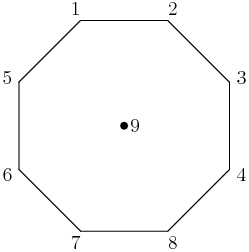

copeland
2013-02-21 19:46:00
Alternatively, there are 4! ways to assign each pair, and then 24 ways to order the pairs.
Alternatively, there are 4! ways to assign each pair, and then 24 ways to order the pairs.
copeland
2013-02-21 19:46:07
How many labellings are there with j=1?
How many labellings are there with j=1?
alquila
2013-02-21 19:46:26
384
384
EpicMath31415
2013-02-21 19:46:26
Same?
Same?
bestwillcui1
2013-02-21 19:46:26
384 as well
384 as well
AlcumusGuy
2013-02-21 19:46:26
same thing: 384
same thing: 384
NathanV
2013-02-21 19:46:26
same number, 384
same number, 384
googol.plex
2013-02-21 19:46:26
same, 384
same, 384
crastybow
2013-02-21 19:46:26
Same. 384
Same. 384
kdokmeci
2013-02-21 19:46:26
The same number.
The same number.
lakshmi_leo
2013-02-21 19:46:26
same number 384
same number 384
nuggetfan
2013-02-21 19:46:26
the same - 384
the same - 384
copeland
2013-02-21 19:46:31
If j=1 then S=(45−1)/4=11. We could go through a similar argument from before to show that there are 384 of them, but there are a couple of simpler ways to see that. How?
If j=1 then S=(45−1)/4=11. We could go through a similar argument from before to show that there are 384 of them, but there are a couple of simpler ways to see that. How?
i8sumpi
2013-02-21 19:47:22
symmetry tells the same
symmetry tells the same
thecmd999
2013-02-21 19:47:22
just reflect over 5
just reflect over 5
centralbs
2013-02-21 19:47:22
the sums are symmetric about 5.5
the sums are symmetric about 5.5
theone142857
2013-02-21 19:47:22
Send i to 9-i. It's a bijection
Send i to 9-i. It's a bijection
AlcumusGuy
2013-02-21 19:47:22
1 and 9 are symmetric about 5
1 and 9 are symmetric about 5
alwinwillwin
2013-02-21 19:47:22
it's the complement
it's the complement
j2002
2013-02-21 19:47:22
j-8, everything else +1.
j-8, everything else +1.
copeland
2013-02-21 19:47:26
We can just add one to each of the 8 outer values in a j=9 configuration to get a j=1 configuration.
We can just add one to each of the 8 outer values in a j=9 configuration to get a j=1 configuration.
copeland
2013-02-21 19:47:31
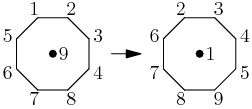

copeland
2013-02-21 19:47:32
Or we could subtract every value from 10:
Or we could subtract every value from 10:
copeland
2013-02-21 19:48:07
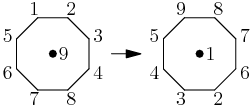

copeland
2013-02-21 19:48:49
How many labellings are there with j=5?
How many labellings are there with j=5?
ninjataco
2013-02-21 19:49:11
same 384
same 384
JFC
2013-02-21 19:49:11
Again, 384
Again, 384
jeremylu
2013-02-21 19:49:11
384
384
chenmichael9
2013-02-21 19:49:11
384
384
anthonyjang
2013-02-21 19:49:11
384. same thing
384. same thing
sparkles257
2013-02-21 19:49:11
384
384
mathfuns
2013-02-21 19:49:11
384
384
Archimedes10
2013-02-21 19:49:11
384 again!
384 again!
Ty330
2013-02-21 19:49:11
384 the same
384 the same
vinayak-kumar
2013-02-21 19:49:11
384
384
copeland
2013-02-21 19:49:19
If we add 1 to all the bigger values in a j=9 solution we get a j=5 solution.
If we add 1 to all the bigger values in a j=9 solution we get a j=5 solution.
copeland
2013-02-21 19:49:25
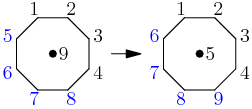

copeland
2013-02-21 19:49:27
There are also 384 of these.
There are also 384 of these.
copeland
2013-02-21 19:49:31
How many total labellings are there?
How many total labellings are there?
regularperson
2013-02-21 19:49:56
1152
1152
kli2000
2013-02-21 19:49:56
1152
1152
Iwilllose
2013-02-21 19:49:56
Adding these up, we get 1152, answerr C
Adding these up, we get 1152, answerr C
viker
2013-02-21 19:49:56
1152
1152
54math
2013-02-21 19:49:56
384*3
384*3
mydogcanpur
2013-02-21 19:49:56
1152 (C)
1152 (C)
austintatious
2013-02-21 19:49:56
384 X 3
384 X 3
swimmerstar
2013-02-21 19:49:56
c 1152
c 1152
ProblemSolver1026
2013-02-21 19:49:56
C, 1152
C, 1152
HiddenMathlete
2013-02-21 19:49:56
3*384
3*384
Voytek
2013-02-21 19:49:56
384*3=1152 or answer C
384*3=1152 or answer C
copeland
2013-02-21 19:49:59
The answer is 384+384+384=1152, (C).
The answer is 384+384+384=1152, (C).
copeland
2013-02-21 19:50:20
I seem to have a poor missing picture up there for some of you.
I seem to have a poor missing picture up there for some of you.
copeland
2013-02-21 19:50:23
It should be like this:
It should be like this:
copeland
2013-02-21 19:50:31


copeland
2013-02-21 19:51:03


copeland
2013-02-21 19:51:11
Let's stop at the first sentence, "In triangle ABC, AB=13, BC=14, and CA=15." This triangle should be in your bag of tricks.
Let's stop at the first sentence, "In triangle ABC, AB=13, BC=14, and CA=15." This triangle should be in your bag of tricks.
copeland
2013-02-21 19:51:17
What is the length of the altitude to ¯BC?
What is the length of the altitude to ¯BC?
swe1
2013-02-21 19:51:48
altitude is 12
altitude is 12
Lord.of.AMC
2013-02-21 19:51:48
12
12
guilt
2013-02-21 19:51:48
12
12
RelaxationUtopia
2013-02-21 19:51:48
12
12
henrikjb
2013-02-21 19:51:48
altituda of 12
altituda of 12
matholympiad25
2013-02-21 19:51:48
12
12
blueberrysc7
2013-02-21 19:51:48
12
12
USAMOREAPER
2013-02-21 19:51:48
12
12
matticus42
2013-02-21 19:51:48
12
12
mbt123
2013-02-21 19:51:48
12
12
19oshawott98
2013-02-21 19:51:48
12
12
linpaws
2013-02-21 19:51:48
12
12
mapletree14
2013-02-21 19:51:48
12
12
copeland
2013-02-21 19:51:53
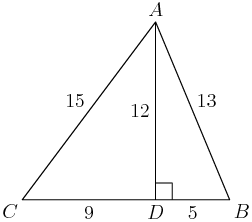

copeland
2013-02-21 19:51:55
The other altitudes are also almost as nice.
The other altitudes are also almost as nice.
copeland
2013-02-21 19:51:59
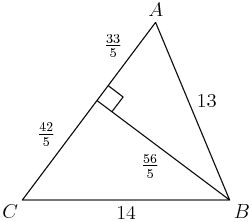

copeland
2013-02-21 19:52:03
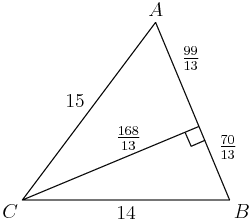

copeland
2013-02-21 19:52:08
You can get these last two by chasing similar triangles from the first triangle or by applying the Pythagorean Theorem.
You can get these last two by chasing similar triangles from the first triangle or by applying the Pythagorean Theorem.
vinayak-kumar
2013-02-21 19:52:20
Wow, thats really nice
Wow, thats really nice
copeland
2013-02-21 19:52:23
Yeah.
Yeah.
copeland
2013-02-21 19:52:35
You'll see this triangle pop up every few years on some contest or another.
You'll see this triangle pop up every few years on some contest or another.
copeland
2013-02-21 19:52:39
When I solved this problem, I used a lot of these facts, and made a great big mess. It worked, but it's not something I'd be comfortable doing again with all of you watching.
When I solved this problem, I used a lot of these facts, and made a great big mess. It worked, but it's not something I'd be comfortable doing again with all of you watching.
copeland
2013-02-21 19:52:47
Instead we'll be a little smarter.
Instead we'll be a little smarter.
copeland
2013-02-21 19:52:53
Our point D is good, though:
Our point D is good, though:
copeland
2013-02-21 19:52:56


copeland
2013-02-21 19:53:03
Next we drop a perpendicular from D to AC.
Next we drop a perpendicular from D to AC.
copeland
2013-02-21 19:53:08
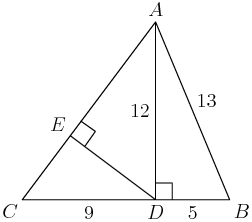

copeland
2013-02-21 19:53:16
Can we say anything about lengths in this diagram?
Can we say anything about lengths in this diagram?
kdokmeci
2013-02-21 19:54:15
Simlar triangles?
Simlar triangles?
wcao9311
2013-02-21 19:54:15
similar
similar
nalaxone44
2013-02-21 19:54:15
DE=36/5
DE=36/5
PERFECTION
2013-02-21 19:54:15
DE=36/5
DE=36/5
coldsummer
2013-02-21 19:54:15
DE=36/5
DE=36/5
dantx5
2013-02-21 19:54:15
ED = 36/5
ED = 36/5
VietaFan
2013-02-21 19:54:15
3-4-5 and 5-12-13 right triangles
3-4-5 and 5-12-13 right triangles
theone142857
2013-02-21 19:54:15
We can find DE, AE, CE by using similar triangles
We can find DE, AE, CE by using similar triangles
googol.plex
2013-02-21 19:54:15
yes, we have similar triangles so CE=27/5, DE=36/5, AE=48/5
yes, we have similar triangles so CE=27/5, DE=36/5, AE=48/5
centralbs
2013-02-21 19:54:15
ED is 36/5 by similar triangles
ED is 36/5 by similar triangles
copeland
2013-02-21 19:54:19
△CED is similar to △CDA, which is 3-4-5. Therefore CE=35⋅9=275. That makes EA=CA−CE=15−275=485.
△CED is similar to △CDA, which is 3-4-5. Therefore CE=35⋅9=275. That makes EA=CA−CE=15−275=485.
copeland
2013-02-21 19:54:24
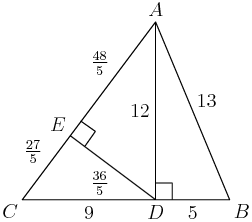

copeland
2013-02-21 19:54:28
Now F is somewhere on ¯DE such that ∠AFB is a right angle. What is the locus of all the points that give right angles?
Now F is somewhere on ¯DE such that ∠AFB is a right angle. What is the locus of all the points that give right angles?
nuggetfan
2013-02-21 19:55:09
circle
circle
ic1999
2013-02-21 19:55:09
circle
circle
Piya31415
2013-02-21 19:55:09
circle with diameter ab
circle with diameter ab
bobthesmartypants
2013-02-21 19:55:09
a circle!
a circle!
theone142857
2013-02-21 19:55:09
circle with diameter AB
circle with diameter AB
flyrain
2013-02-21 19:55:09
a circle
a circle
mathwizard888
2013-02-21 19:55:09
circle with diameter AB
circle with diameter AB
Lord.of.AMC
2013-02-21 19:55:09
the ones on the semicircle with diameter AB
the ones on the semicircle with diameter AB
joshxiong
2013-02-21 19:55:09
The circle with diameter AB.
The circle with diameter AB.
copeland
2013-02-21 19:55:11
In order for ∠AFB to be a right angle, F must be on the circle with diameter ¯AB, and all of these points do produce a right angle.
In order for ∠AFB to be a right angle, F must be on the circle with diameter ¯AB, and all of these points do produce a right angle.
copeland
2013-02-21 19:55:24
(And a "locus" is just a fancy word for set, if you are a geometer.)
(And a "locus" is just a fancy word for set, if you are a geometer.)
copeland
2013-02-21 19:55:30
Know anything else about this circle?
Know anything else about this circle?
mcdonalds106_7
2013-02-21 19:55:56
circle with AB on diameter, this happens to contain D as well
circle with AB on diameter, this happens to contain D as well
alwinwillwin
2013-02-21 19:55:56
it's a cyclic quadrilateral!
it's a cyclic quadrilateral!
mcdonalds106_7
2013-02-21 19:55:56
D is on it
D is on it
theone142857
2013-02-21 19:55:56
It's the circumcircle of ABD
It's the circumcircle of ABD
coldsummer
2013-02-21 19:55:56
intersects D
intersects D
number.sense
2013-02-21 19:55:56
cicumcircle of ABD
cicumcircle of ABD
Aplus95
2013-02-21 19:55:56
Passes through D
Passes through D
mbt123
2013-02-21 19:55:56
amust go throguh point D
amust go throguh point D
copeland
2013-02-21 19:56:00
D is also on this circle. Here it is:
D is also on this circle. Here it is:
copeland
2013-02-21 19:56:04
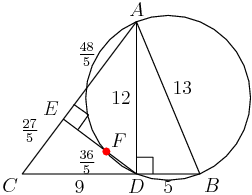

copeland
2013-02-21 19:56:06
OK, that's a lot of stuff. How can we get an expression with EF in it?
OK, that's a lot of stuff. How can we get an expression with EF in it?
nuggetfan
2013-02-21 19:56:41
power of a point?
power of a point?
number.sense
2013-02-21 19:56:41
Power of a point should be good
Power of a point should be good
AkshajK
2013-02-21 19:56:41
Powerpoint
Powerpoint
anthonyjang
2013-02-21 19:56:41
power of a point
power of a point
pi37
2013-02-21 19:56:41
POP
POP
TigerSneak1
2013-02-21 19:56:41
power of a point
power of a point
Smokkala
2013-02-21 19:56:41
power of a point
power of a point
kli2000
2013-02-21 19:56:41
power of a point!
power of a point!
copeland
2013-02-21 19:56:57
Yeah. If you got this far on the test and haven't used Power of a Point, now must be the time.
Yeah. If you got this far on the test and haven't used Power of a Point, now must be the time.
copeland
2013-02-21 19:57:01
We can use power of a point on the line through E and D. However we need another line through E to compare to. The obvious choice is the line through E and A. Let's name that other intersection X.
We can use power of a point on the line through E and D. However we need another line through E to compare to. The obvious choice is the line through E and A. Let's name that other intersection X.
copeland
2013-02-21 19:57:06
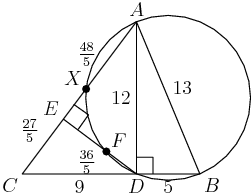

copeland
2013-02-21 19:57:11
What does Power of a Point say for E?
What does Power of a Point say for E?
matholympiad25
2013-02-21 19:57:58
EF*ED=EX*EA
EF*ED=EX*EA
swe1
2013-02-21 19:57:58
EF*ED=EX*EA
EF*ED=EX*EA
Doooooooooot
2013-02-21 19:57:58
EX*EA = EF*ED
EX*EA = EF*ED
Hydroxide
2013-02-21 19:57:58
EF*ED=EX*EA
EF*ED=EX*EA
Colomnt
2013-02-21 19:57:58
EF * ED = EX * EA
EF * ED = EX * EA
RelaxationUtopia
2013-02-21 19:57:58
EF X ED = EX x EA
EF X ED = EX x EA
planetpeter91
2013-02-21 19:57:58
EX*EA=EF*ED
EX*EA=EF*ED
crastybow
2013-02-21 19:57:58
EF*ED = EX*EA
EF*ED = EX*EA
bookworm83197
2013-02-21 19:57:58
EF*ED=EX*EA
EF*ED=EX*EA
i8sumpi
2013-02-21 19:57:58
EX*(48/5)=EF*(36/5)
EX*(48/5)=EF*(36/5)
copeland
2013-02-21 19:58:02
We get EX⋅EA=EF⋅ED,soEX⋅485=EF⋅365. We can simplify that to
We get EX⋅EA=EF⋅ED,soEX⋅485=EF⋅365. We can simplify that to
copeland
2013-02-21 19:58:07
4EX=3EF.
4EX=3EF.
copeland
2013-02-21 19:58:10
(Another 3:4:5 triangle, for what it's worth - that's how Power of a Point works.)
(Another 3:4:5 triangle, for what it's worth - that's how Power of a Point works.)
copeland
2013-02-21 19:58:22
Now what can we use to get EX?
Now what can we use to get EX?
Lord.of.AMC
2013-02-21 19:59:15
POP C
POP C
viker
2013-02-21 19:59:15
Power of a point?
Power of a point?
vinayak-kumar
2013-02-21 19:59:15
similar triangles
similar triangles
regularperson
2013-02-21 19:59:15
Similar Triangles
Similar Triangles
mydogcanpur
2013-02-21 19:59:15
Connect XF and use similar triangles
Connect XF and use similar triangles
flyrain
2013-02-21 19:59:15
Power of a point on C?
Power of a point on C?
ic1999
2013-02-21 19:59:15
power of a point again
power of a point again
copeland
2013-02-21 19:59:33
(Those are, philosophically, the same answer since they'll give the same proportion.)
(Those are, philosophically, the same answer since they'll give the same proportion.)
copeland
2013-02-21 19:59:35
We can also apply Power of a Point to C, givingCD⋅CB=CX⋅CA.
We can also apply Power of a Point to C, givingCD⋅CB=CX⋅CA.
copeland
2013-02-21 19:59:39
Substituting what we know gives9⋅14=CX⋅15.
Substituting what we know gives9⋅14=CX⋅15.
copeland
2013-02-21 19:59:44
Therefore CX=425, so
Therefore CX=425, so
copeland
2013-02-21 20:00:03
EX=CX−CE=425−275=3.
EX=CX−CE=425−275=3.
googol.plex
2013-02-21 20:01:07
EX must be 3
EX must be 3
guilt
2013-02-21 20:01:07
ex = 3 ef =4
ex = 3 ef =4
ws5188
2013-02-21 20:01:07
EX=3
EX=3
zhuangzhuang
2013-02-21 20:01:07
ex=3, so ef=4
ex=3, so ef=4
swe1
2013-02-21 20:01:07
So EF=4
So EF=4
kdokmeci
2013-02-21 20:01:07
EF=4, then
EF=4, then
googol.plex
2013-02-21 20:01:07
so EF is 4 and DF is 16/5
so EF is 4 and DF is 16/5
number.sense
2013-02-21 20:01:07
We could drop a perpendicular from B (we know the altitude), and then use that to get AX by pythagorean theorem on BXA - then EA - AX = EX --> our answer (16/5) --> 21
We could drop a perpendicular from B (we know the altitude), and then use that to get AX by pythagorean theorem on BXA - then EA - AX = EX --> our answer (16/5) --> 21
Lord.of.AMC
2013-02-21 20:01:07
EX = 3 and thus EF = 4 and thus FD = 16/5 and 16+5 = 21
EX = 3 and thus EF = 4 and thus FD = 16/5 and 16+5 = 21
nalaxone44
2013-02-21 20:01:07
EF=4, so DF=36/5-4=16/5
EF=4, so DF=36/5-4=16/5
mathmaster2012
2013-02-21 20:01:07
EF=4
EF=4
AkshajK
2013-02-21 20:01:07


PERFECTION
2013-02-21 20:01:07
so therefore EF=4
so therefore EF=4
sarvottam
2013-02-21 20:01:07
EF=4
EF=4
anthonyjang
2013-02-21 20:01:07
EF=4, 36/5 - 4=16/5, sum is 21
EF=4, 36/5 - 4=16/5, sum is 21
Aplus95
2013-02-21 20:01:07
EF = 4, DF = DE-EF = 36/5 - 4 = 16/5
EF = 4, DF = DE-EF = 36/5 - 4 = 16/5
i8sumpi
2013-02-21 20:01:07
Therefore EF=16/5. 16+5=21 B.
Therefore EF=16/5. 16+5=21 B.
guilt
2013-02-21 20:01:07
and ef =4. thus df = 36/5 - 4 = 16/5 16+5 =21 B
and ef =4. thus df = 36/5 - 4 = 16/5 16+5 =21 B
ninjataco
2013-02-21 20:01:08
and DF is 36/5 - 4 = 16/5?
and DF is 36/5 - 4 = 16/5?
copeland
2013-02-21 20:01:11
Since EX=3, we get EF=4. This makes
DF=ED−EF=365−4=165.
Since EX=3, we get EF=4. This makes
DF=ED−EF=365−4=165.
copeland
2013-02-21 20:01:14
Therefore the answer is 16+5=21, (B).
Therefore the answer is 16+5=21, (B).
copeland
2013-02-21 20:01:24
There were a lot of ways to solve this problem.
There were a lot of ways to solve this problem.
copeland
2013-02-21 20:01:45
I see many of you mentioning some other ways to approach our steps or other ways to get some of these values.
I see many of you mentioning some other ways to approach our steps or other ways to get some of these values.
copeland
2013-02-21 20:01:59
I agree. This problem really lends itself to some cool exploration.
I agree. This problem really lends itself to some cool exploration.
vinayak-kumar
2013-02-21 20:02:11
is there a slick one?
is there a slick one?
rpant1
2013-02-21 20:02:11
was this the quickest?
was this the quickest?
copeland
2013-02-21 20:02:17
It's an interesting question.
It's an interesting question.
copeland
2013-02-21 20:02:45
I think that POP has many cousins, and those all give different approaches that are spiritually the same.
I think that POP has many cousins, and those all give different approaches that are spiritually the same.
copeland
2013-02-21 20:02:58
You can use that cyclic quadrilateral to the same ends, for example.
You can use that cyclic quadrilateral to the same ends, for example.
djmathman
2013-02-21 20:03:08
I think the solution involving cyclic quadrilaterals is quickest, but then again that's probably because that's the way I solved it.
I think the solution involving cyclic quadrilaterals is quickest, but then again that's probably because that's the way I solved it.
copeland
2013-02-21 20:03:17
Alright, next problem.
Alright, next problem.
copeland
2013-02-21 20:03:21


copeland
2013-02-21 20:03:27
What kinds of numbers have exactly 4 positive divisors?
What kinds of numbers have exactly 4 positive divisors?
RelaxationUtopia
2013-02-21 20:03:56
P^3 or P1P2
P^3 or P1P2
googol.plex
2013-02-21 20:03:56
prime*different prime
prime*different prime
crastybow
2013-02-21 20:03:56
Cubes of primes, or product of two primes
Cubes of primes, or product of two primes
kli2000
2013-02-21 20:03:56
cubes, and prime * prime
cubes, and prime * prime
AlcumusGuy
2013-02-21 20:03:56
numbers in the form p_1*p_2 and p_1^3
numbers in the form p_1*p_2 and p_1^3
Colomnt
2013-02-21 20:03:56
p_1*p_2 or p^3
p_1*p_2 or p^3
thecmd999
2013-02-21 20:03:56
p^3 or pq for primes p, q
p^3 or pq for primes p, q
centralbs
2013-02-21 20:03:56
p^3 or pq where p and q are primes
p^3 or pq where p and q are primes
copeland
2013-02-21 20:04:00
A number with 4 positive divisors is either p3 for some prime p or is pq with p and q prime.
A number with 4 positive divisors is either p3 for some prime p or is pq with p and q prime.
copeland
2013-02-21 20:04:04
I bet there are some of each. Let's explore the m=p3 type first. If m=p3 then what is n?
I bet there are some of each. Let's explore the m=p3 type first. If m=p3 then what is n?
theone142857
2013-02-21 20:04:29
1+p+p^2+p^3
1+p+p^2+p^3
Hydroxide
2013-02-21 20:04:29
1+p+p^2+p^3
1+p+p^2+p^3
RotomPlasma
2013-02-21 20:04:29
1+p+p^2+p^3
1+p+p^2+p^3
mathwizard888
2013-02-21 20:04:29
p^3+p^2+p+1
p^3+p^2+p+1
crastybow
2013-02-21 20:04:29
p^3+p^2+p+1
p^3+p^2+p+1
bobthesmartypants
2013-02-21 20:04:29
p3+p2+p+1
p3+p2+p+1
copeland
2013-02-21 20:04:33
n=1+p+p2+p3.
n=1+p+p2+p3.
copeland
2013-02-21 20:04:38
For what p is that in the neighborhood of 2000? (This is the painful part of the problem.)
For what p is that in the neighborhood of 2000? (This is the painful part of the problem.)
matholympiad25
2013-02-21 20:05:18
12, 13ish
12, 13ish
IMGUNNA
2013-02-21 20:05:18
12
12
mydogcanpur
2013-02-21 20:05:18
12
12
viperstrike
2013-02-21 20:05:18
p=13?
p=13?
rafa2be
2013-02-21 20:05:18
13
13
copeland
2013-02-21 20:05:22
If p=10 then 1+p+p2+p3=1111is too small.
If p=10 then 1+p+p2+p3=1111is too small.
copeland
2013-02-21 20:05:26
If p=11 then 1+p+p2+p3=114−111−1=1464.
If p=11 then 1+p+p2+p3=114−111−1=1464.
copeland
2013-02-21 20:05:32
Getting closer. . .
Getting closer. . .
copeland
2013-02-21 20:05:35
If p=12 then 1+p+p2+p3=(1+12)(1+144)=1885
If p=12 then 1+p+p2+p3=(1+12)(1+144)=1885
copeland
2013-02-21 20:05:38
OK, one more.
OK, one more.
copeland
2013-02-21 20:05:46
If p=13 then 1+p+p2+p3=(1+13)(1+169)=2380.
If p=13 then 1+p+p2+p3=(1+13)(1+169)=2380.
Lord.of.AMC
2013-02-21 20:06:06
nope!
nope!
Archimedes10
2013-02-21 20:06:06
NOOOOOOO!!!!
NOOOOOOO!!!!
centralbs
2013-02-21 20:06:06
so none from that case
so none from that case
viker
2013-02-21 20:06:06
That is too big
That is too big
j2002
2013-02-21 20:06:06
None of that type.
None of that type.
NextEinstein
2013-02-21 20:06:06
so none for that case.
so none for that case.
copeland
2013-02-21 20:06:08
Huh. Crazy. They didn't pick a range with any of these type. Crazy. . .
Huh. Crazy. They didn't pick a range with any of these type. Crazy. . .
apple.singer
2013-02-21 20:06:11
(When solving this, I totally didn't realize that m could be p^3. Thankfully it didn't matter )
)
(When solving this, I totally didn't realize that m could be p^3. Thankfully it didn't matter
copeland
2013-02-21 20:06:14
I know, right?
I know, right?
copeland
2013-02-21 20:06:23
Let's look at the m=pq. What is n in this case?
Let's look at the m=pq. What is n in this case?
AkshajK
2013-02-21 20:06:29
Saem
Saem
regularperson
2013-02-21 20:06:29
Same
Same
VietaFan
2013-02-21 20:06:29
me too
me too
mathdoggy
2013-02-21 20:06:29
Me too!
Me too!
mathmaster2012
2013-02-21 20:06:29
Same here!
Same here!
copeland
2013-02-21 20:06:30

swe1
2013-02-21 20:06:51
(p+1)(q+1)
(p+1)(q+1)
planetpeter91
2013-02-21 20:06:51
(p+1)(q+1)
(p+1)(q+1)
ben7
2013-02-21 20:06:51
1+p+q+pq
1+p+q+pq
Wickedestjr
2013-02-21 20:06:51
(p + 1)(q + 1)
(p + 1)(q + 1)
bestwillcui1
2013-02-21 20:06:51
1+p+q+pq
1+p+q+pq
number.sense
2013-02-21 20:06:51
(p+1)(q+1)
(p+1)(q+1)
nuggetfan
2013-02-21 20:06:51
1+p+q+pq
1+p+q+pq
EpicMath31415
2013-02-21 20:06:51
1+p+q+pq
1+p+q+pq
OCed
2013-02-21 20:06:51
(p+1)(q+1)
(p+1)(q+1)
distortedwalrus
2013-02-21 20:06:51
(p+1)(q+1)
(p+1)(q+1)
sparkles257
2013-02-21 20:06:51
(1 + p)(1+q)
(1 + p)(1+q)
nalaxone44
2013-02-21 20:06:51
1+p+pq+q
1+p+pq+q
copeland
2013-02-21 20:06:52
The sum of the divisors of pq is 1+p+q+pq=(p+1)(q+1).
The sum of the divisors of pq is 1+p+q+pq=(p+1)(q+1).
copeland
2013-02-21 20:06:56
Alright, so let's check 2010. How does that factor?
Alright, so let's check 2010. How does that factor?
copeland
2013-02-21 20:07:10
(Was anybody working on math contests 3 years ago? )
)
(Was anybody working on math contests 3 years ago?
djmathman
2013-02-21 20:07:32
2*3*5*67
2*3*5*67
Piya31415
2013-02-21 20:07:32
2,3,67,5
2,3,67,5
kdokmeci
2013-02-21 20:07:32
67*2*3*5
67*2*3*5
mathdoggy
2013-02-21 20:07:32
2 * 67 * 5 * 3
2 * 67 * 5 * 3
Imsacred
2013-02-21 20:07:32
2*3*5*67
2*3*5*67
VietaFan
2013-02-21 20:07:32
2010 = 5*3*2*67
2010 = 5*3*2*67
googol.plex
2013-02-21 20:07:32
2*3*5*67
2*3*5*67
flyrain
2013-02-21 20:07:32
2*5*3*67
2*5*3*67
kdokmeci
2013-02-21 20:07:32
67*2*3*5
67*2*3*5
blippy1998
2013-02-21 20:07:32
2*3*5*67
2*3*5*67
guilt
2013-02-21 20:07:32
2*3*5*67
2*3*5*67
ic1999
2013-02-21 20:07:32
2*3*5*67
2*3*5*67
copeland
2013-02-21 20:07:36
2010=2⋅3⋅5⋅67.
2010=2⋅3⋅5⋅67.
copeland
2013-02-21 20:07:41
Is that of the form (p+1)(q+1)?
Is that of the form (p+1)(q+1)?
RelaxationUtopia
2013-02-21 20:08:26
Notice that the product is divisible by 4, unless one of the primes is 2. Therefore any even number must be divisible by 4.
Notice that the product is divisible by 4, unless one of the primes is 2. Therefore any even number must be divisible by 4.
AlcumusGuy
2013-02-21 20:08:26
No; we need at least 2 factors of 2
No; we need at least 2 factors of 2
RelaxationUtopia
2013-02-21 20:08:26
nope - must have factor of 2 in each product
nope - must have factor of 2 in each product
theone142857
2013-02-21 20:08:26
No, because one is even and one is odd.
No, because one is even and one is odd.
regularperson
2013-02-21 20:08:26
No, because p and q cannot both be odd
No, because p and q cannot both be odd
copeland
2013-02-21 20:08:27
If p and q are both odd, then (p+1)(q+1) is a multiple of 4, but 2010 is not a multiple of 4. The only possibility is that 2010=(2+1)(q+1).
If p and q are both odd, then (p+1)(q+1) is a multiple of 4, but 2010 is not a multiple of 4. The only possibility is that 2010=(2+1)(q+1).
copeland
2013-02-21 20:08:32
Is the solution, q, to this equation prime?
Is the solution, q, to this equation prime?
wmcho1007
2013-02-21 20:08:56
cant be, since if p is 2, then q must be 669 which is not prime
cant be, since if p is 2, then q must be 669 which is not prime
matholympiad25
2013-02-21 20:08:56
q=669, not prime
q=669, not prime
wmcho1007
2013-02-21 20:08:56
in which case, q=669 which is not prime
in which case, q=669 which is not prime
theone142857
2013-02-21 20:08:56
no 669, is not prime
no 669, is not prime
googol.plex
2013-02-21 20:08:56
669 is 3*223
669 is 3*223
AlcumusGuy
2013-02-21 20:08:56
q = 669, which is divisible by 3
q = 669, which is divisible by 3
regularperson
2013-02-21 20:08:56
It is 669, which is divisible by
It is 669, which is divisible by
copeland
2013-02-21 20:08:59
We write 2010=(2+1)(669+1).
We write 2010=(2+1)(669+1).
copeland
2013-02-21 20:09:02
But 669 is not prime since it is a multipile of 3.
But 669 is not prime since it is a multipile of 3.
copeland
2013-02-21 20:09:05
One down. . .
One down. . .
copeland
2013-02-21 20:09:12
Let's explore the parity of p and q a little more.
Let's explore the parity of p and q a little more.
copeland
2013-02-21 20:09:16
If p=2 then (p+1)(q+1)=3(q+1) is a multiple of 6.
If p=2 then (p+1)(q+1)=3(q+1) is a multiple of 6.
copeland
2013-02-21 20:09:19
If p and q are both odd, then (p+1)(q+1) is a multiple of 4.
If p and q are both odd, then (p+1)(q+1) is a multiple of 4.
copeland
2013-02-21 20:09:25
N div by 4 div by 6 2010NoYes2011NoNo2012YesNo2013NoNo2014NoNo2015NoNo2016YesYes2017NoNo2018NoNo2019NoNo
N div by 4 div by 6 2010NoYes2011NoNo2012YesNo2013NoNo2014NoNo2015NoNo2016YesYes2017NoNo2018NoNo2019NoNo
copeland
2013-02-21 20:09:32
We know that 2010 fails.
We know that 2010 fails.
copeland
2013-02-21 20:09:35
What about 2012?
What about 2012?
AlcumusGuy
2013-02-21 20:10:37
2^2 * 503, but it won't work
2^2 * 503, but it won't work
VietaFan
2013-02-21 20:10:37
2012 = 503*4 fails
2012 = 503*4 fails
bobthesmartypants
2013-02-21 20:10:37
2012=2*2*503
2012=2*2*503
zhuangzhuang
2013-02-21 20:10:37
2^2*503, fails
2^2*503, fails
Lord.of.AMC
2013-02-21 20:10:37
no, 2012 = 2*503 but 503 is prime already
no, 2012 = 2*503 but 503 is prime already
mikhailgromov
2013-02-21 20:10:37
2012/4=503
2012/4=503
RelaxationUtopia
2013-02-21 20:10:37
It fails too - try with two fours and get 503 as prime and it doesn't work
It fails too - try with two fours and get 503 as prime and it doesn't work
ws5188
2013-02-21 20:10:37
2*2*503
2*2*503
dardarmath
2013-02-21 20:10:37
2012= 4*503
2012= 4*503
willwin
2013-02-21 20:10:37
2^2*503
2^2*503
copeland
2013-02-21 20:10:41
When we factor 2012, we get 2012=22⋅503, and 503 is prime. This one fails, too.
When we factor 2012, we get 2012=22⋅503, and 503 is prime. This one fails, too.
copeland
2013-02-21 20:10:56
So what's the answer to this problem?
So what's the answer to this problem?
theone142857
2013-02-21 20:11:29
Looking at the answer choices we see that it must be 1
Looking at the answer choices we see that it must be 1
mydogcanpur
2013-02-21 20:11:29
2016 is the only one left (A)
2016 is the only one left (A)
mathfuns
2013-02-21 20:11:29
1
1
Hydroxide
2013-02-21 20:11:29
1
1
Lord.of.AMC
2013-02-21 20:11:29
ans is 1
ans is 1
guilt
2013-02-21 20:11:29
since there is no answer choice 0 it must be a 1
since there is no answer choice 0 it must be a 1
PERFECTION
2013-02-21 20:11:29
so only one that is nice is 2016, so 1, A
so only one that is nice is 2016, so 1, A
willwang123
2013-02-21 20:11:29
(A)=1
(A)=1
AlcumusGuy
2013-02-21 20:11:29
2016 must work, so 1
2016 must work, so 1
VietaFan
2013-02-21 20:11:29
Since 1 is the lowest it is 1
Since 1 is the lowest it is 1
AnishS
2013-02-21 20:11:29
1 the only number is 2016
1 the only number is 2016
wmcho1007
2013-02-21 20:11:29
only 2016 is possible choice, so A
only 2016 is possible choice, so A
copeland
2013-02-21 20:11:33
Since 2016 is the only possible success, and we know the smallest available answer is 1, 2016 must be a success. The answer must be (A).
Since 2016 is the only possible success, and we know the smallest available answer is 1, 2016 must be a success. The answer must be (A).
copeland
2013-02-21 20:11:38
That's pretty unsatisfying, using the answer choices to show existence. Do you see an actual factorization?
That's pretty unsatisfying, using the answer choices to show existence. Do you see an actual factorization?
Lord.of.AMC
2013-02-21 20:12:27
2016 works, (1+41)(1+47)
2016 works, (1+41)(1+47)
RelaxationUtopia
2013-02-21 20:12:27
The number m is 1509, because 1509+503+3+1 = 2016
The number m is 1509, because 1509+503+3+1 = 2016
VietaFan
2013-02-21 20:12:27
Testing 2016, we get 2016 = 2*1008 = 8*252. 7 and 251 are both prime.
Testing 2016, we get 2016 = 2*1008 = 8*252. 7 and 251 are both prime.
mathwizard888
2013-02-21 20:12:27
BTW, 2016=(41+1)(47+1)
BTW, 2016=(41+1)(47+1)
PERFECTION
2013-02-21 20:12:27
(41,47) and (3,503) works
(41,47) and (3,503) works
djmathman
2013-02-21 20:12:27
2016=(3+1)(503+1)
2016=(3+1)(503+1)
AlcumusGuy
2013-02-21 20:12:27
2^5 * 3^2 * 7 = 41(47)
2^5 * 3^2 * 7 = 41(47)
copeland
2013-02-21 20:12:33
Since we already factored 2012=4⋅503, and 2016 is 4 greater, we find 2016=(3+1)(503+1)with 503 prime.
Since we already factored 2012=4⋅503, and 2016 is 4 greater, we find 2016=(3+1)(503+1)with 503 prime.
copeland
2013-02-21 20:12:42
We also get lots of other valid factorizations,2016=(7+1)(251+1)=(11+1)(167+1)=(23+1)(83+1)=(41+1)(47+1).
We also get lots of other valid factorizations,2016=(7+1)(251+1)=(11+1)(167+1)=(23+1)(83+1)=(41+1)(47+1).
Imsacred
2013-02-21 20:13:00
maybe in the year 2380ish AMC will recycle this problem so p^3 becomes relevant
maybe in the year 2380ish AMC will recycle this problem so p^3 becomes relevant
copeland
2013-02-21 20:13:12
"Memmed it. That was on the AMC 3 centuries ago. . ."
"Memmed it. That was on the AMC 3 centuries ago. . ."
copeland
2013-02-21 20:13:23
Alright. This problem. . .
Alright. This problem. . .
copeland
2013-02-21 20:13:26
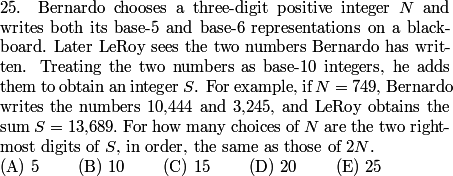

copeland
2013-02-21 20:13:37
Ever notice how the confused characters in math problems are all number theorists? It's never, "Bernardo draws a circle on the blackboard and later Leroy thinks it's a pentagon. . ."
Ever notice how the confused characters in math problems are all number theorists? It's never, "Bernardo draws a circle on the blackboard and later Leroy thinks it's a pentagon. . ."
copeland
2013-02-21 20:13:48
In this type of number theory problem, where we take an integer as input (N here) and get something as output (the last two digits of whatever LeRoy created), I like to start by figuring out the period of operation. What's the period here? (When does the output start repeating?)
In this type of number theory problem, where we take an integer as input (N here) and get something as output (the last two digits of whatever LeRoy created), I like to start by figuring out the period of operation. What's the period here? (When does the output start repeating?)
matholympiad25
2013-02-21 20:14:51
Every 900
Every 900
googol.plex
2013-02-21 20:14:51
well we have obvious repeats every 900...
well we have obvious repeats every 900...
willwang123
2013-02-21 20:14:51
no wait 25*36=900
no wait 25*36=900
joshxiong
2013-02-21 20:14:51
25*36=900
25*36=900
Piya31415
2013-02-21 20:14:51
900?
900?
googol.plex
2013-02-21 20:14:51
25*36 is 900, and when you do that the tens and units stay the same
25*36 is 900, and when you do that the tens and units stay the same
theone142857
2013-02-21 20:14:51
5^2*6^2=900
5^2*6^2=900
copeland
2013-02-21 20:14:53
Since the last two digits base 5 representation repeat every 25 terms and the last 2 digits of the base 6 representation repeat every 36 terms, the whole sequence repeats every 25⋅36=900 terms.
Since the last two digits base 5 representation repeat every 25 terms and the last 2 digits of the base 6 representation repeat every 36 terms, the whole sequence repeats every 25⋅36=900 terms.
copeland
2013-02-21 20:14:57
The period is thus (a factor of) 900.
The period is thus (a factor of) 900.
copeland
2013-02-21 20:15:00
Is that interesting?
Is that interesting?
apple.singer
2013-02-21 20:15:26
There are 900 3-digit numbers
There are 900 3-digit numbers
Relativity1618
2013-02-21 20:15:26
same number of values for N
same number of values for N
willwang123
2013-02-21 20:15:26
yes because 100-999 is 900 numbers.
yes because 100-999 is 900 numbers.
j2002
2013-02-21 20:15:26
yes all three digit numbers are different mod 900
yes all three digit numbers are different mod 900
Seedleaf
2013-02-21 20:15:26
theres only 900 three digit integers
theres only 900 three digit integers
copeland
2013-02-21 20:15:30
Well, there are exactly 900 three-digit integers, so the set of outputs (counting repeats) from N=100−999 is the same as the set of outputs from 1−900 or 0−899.
Well, there are exactly 900 three-digit integers, so the set of outputs (counting repeats) from N=100−999 is the same as the set of outputs from 1−900 or 0−899.
RelaxationUtopia
2013-02-21 20:15:37
Why are there so many problems involving Bernardo?
Why are there so many problems involving Bernardo?
kdokmeci
2013-02-21 20:15:37
By the way, there were Bernardo and LeRoy on a previuos test, too.
By the way, there were Bernardo and LeRoy on a previuos test, too.
copeland
2013-02-21 20:15:54
These are the chairs of the AMC 10 and AMC 12.
These are the chairs of the AMC 10 and AMC 12.
copeland
2013-02-21 20:16:10
I'm sure when they actually write numbers on a chalkboard, they make a note of the base.
I'm sure when they actually write numbers on a chalkboard, they make a note of the base.
Sesquipedalian
2013-02-21 20:16:22
Why do math people name the things they sit on?
Why do math people name the things they sit on?
copeland
2013-02-21 20:16:32
OK, back to the problem. . .
OK, back to the problem. . .
copeland
2013-02-21 20:16:35
I'm overwhelmed. What should you do when you're overwhelmed with a problem like this?
I'm overwhelmed. What should you do when you're overwhelmed with a problem like this?
Lord.of.AMC
2013-02-21 20:17:11
make it easier
make it easier
theone142857
2013-02-21 20:17:11
Small values
Small values
mathmaster2012
2013-02-21 20:17:11
Experiment!
Experiment!
jasonmathcounts
2013-02-21 20:17:11
try out some numbers
try out some numbers
AlcumusGuy
2013-02-21 20:17:11
do a simpler problem
do a simpler problem
Wickedestjr
2013-02-21 20:17:11
Test a few example numbers
Test a few example numbers
richard4912
2013-02-21 20:17:11
smaller cases
smaller cases
54math
2013-02-21 20:17:11
try a simplier version
try a simplier version
copeland
2013-02-21 20:17:14
Two important strategies come to mind here: reduce to a simpler problem and try some examples.
Two important strategies come to mind here: reduce to a simpler problem and try some examples.
copeland
2013-02-21 20:17:18
What's the simpler problem?
What's the simpler problem?
Jerry1997
2013-02-21 20:17:44
1 digit
1 digit
RelaxationUtopia
2013-02-21 20:17:44
Just base 5 or base 6 unit digit
Just base 5 or base 6 unit digit
googol.plex
2013-02-21 20:17:44
only last digits?
only last digits?
willwang123
2013-02-21 20:17:44
a 1-digit positive integer
a 1-digit positive integer
mikhailgromov
2013-02-21 20:17:44
Last digit
Last digit
mathman98
2013-02-21 20:17:44
One digit integers
One digit integers
colinhy
2013-02-21 20:17:44
only the last digit is the same as that of 2N?
only the last digit is the same as that of 2N?
copeland
2013-02-21 20:17:49
Let's just look at the units digits. What's the period when we look at only the units digit?
Let's just look at the units digits. What's the period when we look at only the units digit?
AkshajK
2013-02-21 20:18:11
30
30
nuggetfan
2013-02-21 20:18:11
30
30
Hydroxide
2013-02-21 20:18:11
30
30
AnishS
2013-02-21 20:18:11
30
30
sparkles257
2013-02-21 20:18:11
30
30
VietaFan
2013-02-21 20:18:11
30
30
regularperson
2013-02-21 20:18:11
30
30
swe1
2013-02-21 20:18:11
30
30
vinayak-kumar
2013-02-21 20:18:11
5*6=30
5*6=30
copeland
2013-02-21 20:18:13
The period is 5⋅6=30.
The period is 5⋅6=30.
copeland
2013-02-21 20:18:16
I can write a table for the first few, only keeping track of the units digit:
I can write a table for the first few, only keeping track of the units digit:
copeland
2013-02-21 20:18:18
N base 5 base 6 S 00001112222433364448
N base 5 base 6 S 00001112222433364448
copeland
2013-02-21 20:18:27
Huh. The first 5 all have units digit equal to 2N. I'm starting to think the answer might be 900. . . .
Huh. The first 5 all have units digit equal to 2N. I'm starting to think the answer might be 900. . . .
copeland
2013-02-21 20:18:31
N base 5 base 6 S 000011122224333644485055610172138325943710044
N base 5 base 6 S 000011122224333644485055610172138325943710044
copeland
2013-02-21 20:18:35
OK, the next few are not so hot.
OK, the next few are not so hot.
copeland
2013-02-21 20:18:48
I don't have any bright ideas. However, I do have a lot of paper, and this is going pretty fast.
I don't have any bright ideas. However, I do have a lot of paper, and this is going pretty fast.
copeland
2013-02-21 20:18:54
What other N from 0-29 work?
What other N from 0-29 work?
Seedleaf
2013-02-21 20:19:47
just 0,1,2,3,4
just 0,1,2,3,4
regularperson
2013-02-21 20:19:47
None
None
theone142857
2013-02-21 20:19:47
none
none
alphaReally
2013-02-21 20:19:47
none
none
anonymous0
2013-02-21 20:19:47
none?
none?
OCed
2013-02-21 20:19:47
None.
None.
billgates42
2013-02-21 20:19:47
None
None
burch_c
2013-02-21 20:19:47
none
none
copeland
2013-02-21 20:19:51
None of them do!
None of them do!
copeland
2013-02-21 20:19:54
N base 5 base 6 S 00001112222433364448505561017213832594371004411156122021331414426150331614517257183031941520022211342224623358244042501126123272362834729459
N base 5 base 6 S 00001112222433364448505561017213832594371004411156122021331414426150331614517257183031941520022211342224623358244042501126123272362834729459
copeland
2013-02-21 20:20:07
Alright, what did we just show? Does our 1-digit experiment tell us anything about the 2-digit case?
Alright, what did we just show? Does our 1-digit experiment tell us anything about the 2-digit case?
RelaxationUtopia
2013-02-21 20:21:10
OH so the only ones we have to consider for the second condition are those congruent to the first 5 mod 30!!
OH so the only ones we have to consider for the second condition are those congruent to the first 5 mod 30!!
matholympiad25
2013-02-21 20:21:10
We can simplify our work even more by just considering the unit digit equalling 0 case
We can simplify our work even more by just considering the unit digit equalling 0 case
apple.singer
2013-02-21 20:21:10
Well all the numbers in the 2-digit case must be 0-4 mod 30
Well all the numbers in the 2-digit case must be 0-4 mod 30
Jerry1997
2013-02-21 20:21:10
only 0,1,2,3,4 mod (30) can work at all for 2 digits?
only 0,1,2,3,4 mod (30) can work at all for 2 digits?
ic1999
2013-02-21 20:21:10
we only need to try first 5 of every 30
we only need to try first 5 of every 30
copeland
2013-02-21 20:21:11
We know that the units digit in the 2-digit case is just the 1-digit case again. We also know that the units digits repeat every 30 and that we need N to be 0,1,2,3,4, or 5 modulo 30 in order to work. Therefore we know N=30M+0, 30M+1, 30M+2, 30M+3, or 30M+4.
We know that the units digit in the 2-digit case is just the 1-digit case again. We also know that the units digits repeat every 30 and that we need N to be 0,1,2,3,4, or 5 modulo 30 in order to work. Therefore we know N=30M+0, 30M+1, 30M+2, 30M+3, or 30M+4.
copeland
2013-02-21 20:21:19
And how does the choice 0, 1, 2, 3, or 4 affect the tens digit?
And how does the choice 0, 1, 2, 3, or 4 affect the tens digit?
Voytek
2013-02-21 20:22:17
It doesn't.
It doesn't.
mydogcanpur
2013-02-21 20:22:17
It doesn't
It doesn't
billgates42
2013-02-21 20:22:17
It doesnt affect it
It doesnt affect it
numbertheory
2013-02-21 20:22:17
it doesn't
it doesn't
apple.singer
2013-02-21 20:22:17
not at all?
not at all?
Ty330
2013-02-21 20:22:17
None whatsoever
None whatsoever
copeland
2013-02-21 20:22:21
It doesn't. There is no carrying since the largest value we get is 4+4<10.
It doesn't. There is no carrying since the largest value we get is 4+4<10.
copeland
2013-02-21 20:22:28
So for each M, either all 5 work or none of them work.
So for each M, either all 5 work or none of them work.
copeland
2013-02-21 20:22:31
So now is it time to think of something clever to do?
So now is it time to think of something clever to do?
regularperson
2013-02-21 20:23:13
No, keep on going
No, keep on going
anwang16
2013-02-21 20:23:13
try each one? not very clever
try each one? not very clever
mathmaster2012
2013-02-21 20:23:13
Test 1 for each case.
Test 1 for each case.
Jerry1997
2013-02-21 20:23:13
look at 0,30,60,90 and find a pattern
look at 0,30,60,90 and find a pattern
RelaxationUtopia
2013-02-21 20:23:13
Notice that there are 30 repeats so consider one of the unit digits as case and try that for different ten's digits
Notice that there are 30 repeats so consider one of the unit digits as case and try that for different ten's digits
mathman98
2013-02-21 20:23:13
Treat tens digit like one's digit
Treat tens digit like one's digit
copeland
2013-02-21 20:23:16
No. Let's just make another chart and be done with it.
No. Let's just make another chart and be done with it.
copeland
2013-02-21 20:23:21
Cleverness is for suckers.
Cleverness is for suckers.
copeland
2013-02-21 20:23:26
30M+0 base 5 base 6 S 0000000301050606020406090303060120402060150001010180100010210205070240304070270403070300002020330101020360200020390305080420404080450003030480102030510201030540300030570405090600004040630103040660202040690301040720400040750005050780104050810203050840302050870401050
30M+0 base 5 base 6 S 0000000301050606020406090303060120402060150001010180100010210205070240304070270403070300002020330101020360200020390305080420404080450003030480102030510201030540300030570405090600004040630103040660202040690301040720400040750005050780104050810203050840302050870401050
copeland
2013-02-21 20:23:29
Which ones of those are good?
Which ones of those are good?
1ph0ne
2013-02-21 20:24:42
0
0
C00LDUDE
2013-02-21 20:24:42
30
30
Jerry1997
2013-02-21 20:24:42
0 and 30
0 and 30
copeland
2013-02-21 20:24:44
OK, those work.
OK, those work.
copeland
2013-02-21 20:24:48
See any others?
See any others?
mcdonalds106_7
2013-02-21 20:25:27
360,390,720
360,390,720
bookie331
2013-02-21 20:25:27
720
720
alquila
2013-02-21 20:25:27
360,390,720,
360,390,720,
Cobra2010
2013-02-21 20:25:27
720
720
googol.plex
2013-02-21 20:25:27
just 360 390 and 720
just 360 390 and 720
DaChickenInc
2013-02-21 20:25:27
720
720
AlcumusGuy
2013-02-21 20:25:27
and 720
and 720
mathmaster2012
2013-02-21 20:25:27
390,720
390,720
bookie331
2013-02-21 20:25:27
390 and 720
390 and 720
nuggetfan
2013-02-21 20:25:27
360, 390, 720
360, 390, 720
danielguo94
2013-02-21 20:25:27
360
360
distortedwalrus
2013-02-21 20:25:27
720
720
copeland
2013-02-21 20:25:41
Here are the winners, 0, 30, 360, 390, and 720.
Here are the winners, 0, 30, 360, 390, and 720.
copeland
2013-02-21 20:25:45
30M+0 base 5 base 6 S 0000000301050606020406090303060120402060150001010180100010210205070240304070270403070300002020330101020360200020390305080420404080450003030480102030510201030540300030570405090600004040630103040660202040690301040720400040750005050780104050810203050840302050870401050
30M+0 base 5 base 6 S 0000000301050606020406090303060120402060150001010180100010210205070240304070270403070300002020330101020360200020390305080420404080450003030480102030510201030540300030570405090600004040630103040660202040690301040720400040750005050780104050810203050840302050870401050
copeland
2013-02-21 20:25:53
So what's the answer?
So what's the answer?
anthonyjang
2013-02-21 20:26:42
E, 25?
E, 25?
vinayak-kumar
2013-02-21 20:26:42
5*5=(E) 25
5*5=(E) 25
regularperson
2013-02-21 20:26:42
WE HAVE 5 WINNERS! 5 CHOICES FOR EACH, OUR ANSWER IS 25!
WE HAVE 5 WINNERS! 5 CHOICES FOR EACH, OUR ANSWER IS 25!
Ty330
2013-02-21 20:26:42
5*5 = 25
5*5 = 25
savefiles
2013-02-21 20:26:42
E!
E!
Lord.of.AMC
2013-02-21 20:26:42
5*5 = 25
5*5 = 25
VietaFan
2013-02-21 20:26:42
25, 5 last digits for each
25, 5 last digits for each
amoghgaitonde
2013-02-21 20:26:42
25 (E)
25 (E)
zhuangzhuang
2013-02-21 20:26:42
25
25
Mrdavid445
2013-02-21 20:26:42
25
25
Lord.of.AMC
2013-02-21 20:26:42
5 for the units, 5 for tens, 5*5 = 25.
5 for the units, 5 for tens, 5*5 = 25.
JFC
2013-02-21 20:26:42
5*5=(E) 25
5*5=(E) 25
ws5188
2013-02-21 20:26:42
25
25
copeland
2013-02-21 20:27:21
There are 5 successful tens digits, and each gets 5 successful ones digits, so the answer is 5⋅5=25, (E).
There are 5 successful tens digits, and each gets 5 successful ones digits, so the answer is 5⋅5=25, (E).
copeland
2013-02-21 20:28:35
A couple of people are unhappy that we included, say, 33. Why is that cool?
A couple of people are unhappy that we included, say, 33. Why is that cool?
copeland
2013-02-21 20:28:41
Why is it cool to include 33?
Why is it cool to include 33?
copeland
2013-02-21 20:28:45
What are we really saying when we count 33?
What are we really saying when we count 33?
apple.singer
2013-02-21 20:29:11
because 933 works just as well
because 933 works just as well
mcdonalds106_7
2013-02-21 20:29:11
add 900 to it
add 900 to it
nuggetfan
2013-02-21 20:29:11
33 (mod 900)
33 (mod 900)
Imsacred
2013-02-21 20:29:11
that 933 works
that 933 works
copeland
2013-02-21 20:29:21
33 is just the residue class mod 900. We're really counting 933 when we say 33 up there.
33 is just the residue class mod 900. We're really counting 933 when we say 33 up there.
copeland
2013-02-21 20:29:29
Incidentally, you might have noticed that in the 1-digit case, there was exactly one solution for each of the five possible ones digits of 2N. You might have conjectured that the same holds for the tens digit. This conjecture does hold and gives a nice quick way to guess that the answer is 25.
Incidentally, you might have noticed that in the 1-digit case, there was exactly one solution for each of the five possible ones digits of 2N. You might have conjectured that the same holds for the tens digit. This conjecture does hold and gives a nice quick way to guess that the answer is 25.
copeland
2013-02-21 20:29:42
(There are more sophisticated ways to solve this problem, but they're not any easier, definitely not any faster, not really that enlightening, and more prone to error.)
(There are more sophisticated ways to solve this problem, but they're not any easier, definitely not any faster, not really that enlightening, and more prone to error.)
copeland
2013-02-21 20:30:00
Oh, look! We just finished the AMC10. Congrats everyone.
Oh, look! We just finished the AMC10. Congrats everyone.
copeland
2013-02-21 20:30:24
Let's take a small break.
Let's take a small break.
copeland
2013-02-21 20:30:47
Everyone give me your favorite one-line proof for Problem 12B, #16.
Everyone give me your favorite one-line proof for Problem 12B, #16.
copeland
2013-02-21 20:30:50


Voytek
2013-02-21 20:33:49
Since 2013=61*3*11 it must have a 61! on top and since 59 is the biggest prime under 61 it must have a 59! on bottom so 61-59=2 (B)
Since 2013=61*3*11 it must have a 61! on top and since 59 is the biggest prime under 61 it must have a 59! on bottom so 61-59=2 (B)
crastybow
2013-02-21 20:33:49
2013 = 3*11*61, b_1 must be the largest prime under 61, so 61-59=2 (B)
2013 = 3*11*61, b_1 must be the largest prime under 61, so 61-59=2 (B)
wcao9311
2013-02-21 20:33:49
2013=61x11x 3, smallest prime under 61 is 59, and 61-59 is 2, we have 59 because you must cancel it out frm r
2013=61x11x 3, smallest prime under 61 is 59, and 61-59 is 2, we have 59 because you must cancel it out frm r
flyrain
2013-02-21 20:33:49
We have 2013=3*11*61. Thus, a_1 has to be 61. We can have 3 included in the 60, and since 59 is prime, we have a_1=61 and b_1=59. Thus, We have 61-59=B) 2
We have 2013=3*11*61. Thus, a_1 has to be 61. We can have 3 included in the 60, and since 59 is prime, we have a_1=61 and b_1=59. Thus, We have 61-59=B) 2
RotomPlasma
2013-02-21 20:33:49
2013=61*11*3, so the top will have 61! as the first term, and the bottom needs to eliminate 60! but 60 can be expressed in smaller factorials so the first term of the denominator will actually be the largest prime smaller than 60 which is 59, so 61-59=2 (B)
2013=61*11*3, so the top will have 61! as the first term, and the bottom needs to eliminate 60! but 60 can be expressed in smaller factorials so the first term of the denominator will actually be the largest prime smaller than 60 which is 59, so 61-59=2 (B)
ajb
2013-02-21 20:33:49
There must be a 61 in the numerator, but the 59 must cancel out, and 60 is clearly possible to cancel without using 60!, so 61-59=2
There must be a 61 in the numerator, but the 59 must cancel out, and 60 is clearly possible to cancel without using 60!, so 61-59=2
teranz0
2013-02-21 20:33:49
61 is the largest prime factor of 2013. 60 has 12 in it, which does not divide 12, so we need to cancel it wit the 60 in 61! by putting 60! on the bottom. 61-60=1
61 is the largest prime factor of 2013. 60 has 12 in it, which does not divide 12, so we need to cancel it wit the 60 in 61! by putting 60! on the bottom. 61-60=1
googol.plex
2013-02-21 20:33:49
We have to have 61 in the numerator, and 59 in the denominator so lets use 61! and 59!. We also need an 11 and a 3 so we have 11! and 3! in numerator and 10! and 2! in denominator. We need another 60 in the denominator, so we put a 5! in the denominator and a 2! in the numerator. Thus 61 is a_1 and 59 is b_1 so we have B 2
We have to have 61 in the numerator, and 59 in the denominator so lets use 61! and 59!. We also need an 11 and a 3 so we have 11! and 3! in numerator and 10! and 2! in denominator. We need another 60 in the denominator, so we put a 5! in the denominator and a 2! in the numerator. Thus 61 is a_1 and 59 is b_1 so we have B 2
RelaxationUtopia
2013-02-21 20:33:49
Or "Oh factorials take up every composite numbers, only ones that matter are the prime ones, namely the largest one. Top must be 61 and bottom can be as low as 59, so 2". I wish I got this on the actual test instead of looking at it and saying 61 and 60 so 1.
Or "Oh factorials take up every composite numbers, only ones that matter are the prime ones, namely the largest one. Top must be 61 and bottom can be as low as 59, so 2". I wish I got this on the actual test instead of looking at it and saying 61 and 60 so 1.
copeland
2013-02-21 20:33:51
When we factor, we get 2013=3⋅11⋅61. We know that we HAVE to have at least 61! in the numerator and we have to have at least a 51! in the denominator. We can build such a representation with those values, so the answer must be a1+b1=61+59=120. These have a diference of 2.
When we factor, we get 2013=3⋅11⋅61. We know that we HAVE to have at least 61! in the numerator and we have to have at least a 51! in the denominator. We can build such a representation with those values, so the answer must be a1+b1=61+59=120. These have a diference of 2.
copeland
2013-02-21 20:34:22
Who's ready for the 12 now?
Who's ready for the 12 now?
AkshajK
2013-02-21 20:35:15
me
me
lostinhyperspace
2013-02-21 20:35:15
me!
me!
theone142857
2013-02-21 20:35:15
me
me
clear
2013-02-21 20:35:15
lets go!
lets go!
Archimedes10
2013-02-21 20:35:15
I am.
I am.
mathman500
2013-02-21 20:35:15
I am!
I am!
mathgenius64
2013-02-21 20:35:15
me
me
gab9810
2013-02-21 20:35:15
2013=7*61*359! not 51!
2013=7*61*359! not 51!
mathdoggy
2013-02-21 20:35:15
everyone
everyone
IceBeam
2013-02-21 20:35:15
I"m Ready!
I"m Ready!
copeland
2013-02-21 20:35:20


copeland
2013-02-21 20:35:23
Uh-oh! Vocabulary question. What's a directrix?
Uh-oh! Vocabulary question. What's a directrix?
thecmd999
2013-02-21 20:36:23
parabolas are equidistant from a fixed point (focus) and a line (directrix)
parabolas are equidistant from a fixed point (focus) and a line (directrix)
1ph0ne
2013-02-21 20:36:23
Opposite from the focus, same distance with the focus fro the vertex.
Opposite from the focus, same distance with the focus fro the vertex.
kdokmeci
2013-02-21 20:36:23
Its the line where theparabola is the same distance from the focus. Uh, so much vocab
Its the line where theparabola is the same distance from the focus. Uh, so much vocab
sammyMaX
2013-02-21 20:36:23
A line. The distance between the directrix and focus is constant
A line. The distance between the directrix and focus is constant
mrwoodpusher
2013-02-21 20:36:23
Parabolas are defined by a line, the directrix, and a point, the focus, and the distance from each point on the parabola to the point and the line are equal.
Parabolas are defined by a line, the directrix, and a point, the focus, and the distance from each point on the parabola to the point and the line are equal.
bookworm83197
2013-02-21 20:36:23
the line which is the same distance away from the point as the focus? :-/
the line which is the same distance away from the point as the focus? :-/
trophies
2013-02-21 20:36:23
Any point on a parabola is equidistant from the focus and the directrix...
Any point on a parabola is equidistant from the focus and the directrix...
distortedwalrus
2013-02-21 20:36:23
the line such that the distance between any point on the parabola and the focus of the parabola equals the distance to that line
the line such that the distance between any point on the parabola and the focus of the parabola equals the distance to that line
copeland
2013-02-21 20:36:29
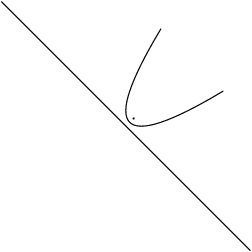

copeland
2013-02-21 20:36:31
Given a point and a line not containing that point, we can construct the locus of all points that are equidistant from the point and line. The line used in this construction is called the directrix of the parabola.
Given a point and a line not containing that point, we can construct the locus of all points that are equidistant from the point and line. The line used in this construction is called the directrix of the parabola.
copeland
2013-02-21 20:36:40
Let's think about when parabolas that share a focus intersect. If we have a parabola with directrix L and focus F and a parabola with directrix K and focus F, and we also have a point X on the parabolas associated to each, what can we say about X?
Let's think about when parabolas that share a focus intersect. If we have a parabola with directrix L and focus F and a parabola with directrix K and focus F, and we also have a point X on the parabolas associated to each, what can we say about X?
copeland
2013-02-21 20:37:07
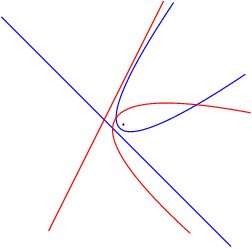

OCed
2013-02-21 20:38:02
It's equidistant from both lines
It's equidistant from both lines
Imsacred
2013-02-21 20:38:02
X is equidistant to K and L
X is equidistant to K and L
swe1
2013-02-21 20:38:02
X is on the angle bisector of directrixes?
X is on the angle bisector of directrixes?
linpaws
2013-02-21 20:38:02
X is equidistant from L and K.
X is equidistant from L and K.
kdokmeci
2013-02-21 20:38:02
Equidistant from each directesx?
Equidistant from each directesx?
mrwoodpusher
2013-02-21 20:38:02
it is equidistant from both lines
it is equidistant from both lines
copeland
2013-02-21 20:38:06
The distance from X to F is the same as the distance from X to L and from X to K.
The distance from X to F is the same as the distance from X to L and from X to K.
copeland
2013-02-21 20:38:09
Therefore the circle with center F and radius XF passes through F. It also has to be tangent to each directrix at the point nearest to X.
Therefore the circle with center F and radius XF passes through F. It also has to be tangent to each directrix at the point nearest to X.
copeland
2013-02-21 20:38:19
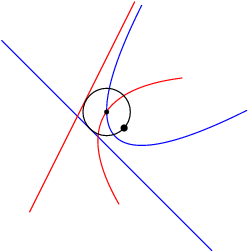

copeland
2013-02-21 20:38:27
How many times do parabolas with non-parallel directrices intersect?
How many times do parabolas with non-parallel directrices intersect?
RelaxationUtopia
2013-02-21 20:39:04
TWO
TWO
Voytek
2013-02-21 20:39:04
2
2
Jerry1997
2013-02-21 20:39:04
2
2
VietaFan
2013-02-21 20:39:04
2
2
djmathman
2013-02-21 20:39:04
twice
twice
roilior
2013-02-21 20:39:04
2 times
2 times
RexT95
2013-02-21 20:39:04
2
2
ninjataco
2013-02-21 20:39:04
twice?
twice?
mathwizard888
2013-02-21 20:39:04
2
2
mprashker
2013-02-21 20:39:04
twice
twice
mssmath
2013-02-21 20:39:04
two
two
joshxiong
2013-02-21 20:39:04
Twice
Twice
copeland
2013-02-21 20:39:08
Two. Given any two lines and any point not on those lines, there are two circles tangent to both lines that contain the point.
Two. Given any two lines and any point not on those lines, there are two circles tangent to both lines that contain the point.
copeland
2013-02-21 20:39:11


copeland
2013-02-21 20:39:15
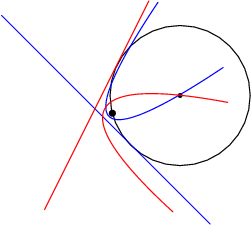

copeland
2013-02-21 20:39:23
There's a nice way to see that.
There's a nice way to see that.
copeland
2013-02-21 20:39:38
The "smaller arc" of the circle, as we move the center away from the intersection, sweeps out the entire region.
The "smaller arc" of the circle, as we move the center away from the intersection, sweeps out the entire region.
copeland
2013-02-21 20:39:44
The "larger arc" does so as well.
The "larger arc" does so as well.
copeland
2013-02-21 20:40:12
There's one time, as we are increasing the radius, that the smaller arc hits the point in its sweeping.
There's one time, as we are increasing the radius, that the smaller arc hits the point in its sweeping.
copeland
2013-02-21 20:40:17
The same holds for the larger arc.
The same holds for the larger arc.
copeland
2013-02-21 20:40:42
What about when the lines are parallel?
What about when the lines are parallel?
ic1999
2013-02-21 20:41:31
none or twice
none or twice
program4
2013-02-21 20:41:31
the parabolae either intersect twice or never
the parabolae either intersect twice or never
colinhy
2013-02-21 20:41:31
Sometimes it will intersect twice but other times it won't intersect
Sometimes it will intersect twice but other times it won't intersect
kli2000
2013-02-21 20:41:31
sometimes 2, sometimes 0
sometimes 2, sometimes 0
copeland
2013-02-21 20:41:35
Ah! There are cases.
Ah! There are cases.
copeland
2013-02-21 20:41:43
When do they intersect?
When do they intersect?
RexT95
2013-02-21 20:42:22
when one is upside down
when one is upside down
number.sense
2013-02-21 20:42:22
when they are oriented in opposite directions
when they are oriented in opposite directions
flyrain
2013-02-21 20:42:22
the point is betwwen the directrixes
the point is betwwen the directrixes
nuggetfan
2013-02-21 20:42:22
when one is on one side and one is on the other
when one is on one side and one is on the other
mcdonalds106_7
2013-02-21 20:42:22
2 iff directrix is on same side of focus
2 iff directrix is on same side of focus
copeland
2013-02-21 20:42:38
If two lines are parallel and we are given a point between them, there are exactly two circles that contain that point.
If two lines are parallel and we are given a point between them, there are exactly two circles that contain that point.
copeland
2013-02-21 20:42:43
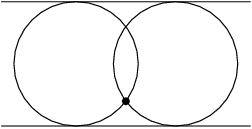

copeland
2013-02-21 20:42:47
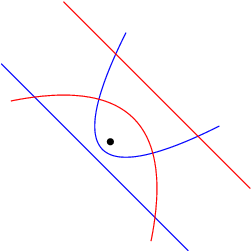

copeland
2013-02-21 20:42:53
However, no circles that are tangent to both lines contain any points outside, so if F is not between the directrices, the two parabolas cannot intersect.
However, no circles that are tangent to both lines contain any points outside, so if F is not between the directrices, the two parabolas cannot intersect.
copeland
2013-02-21 20:43:06
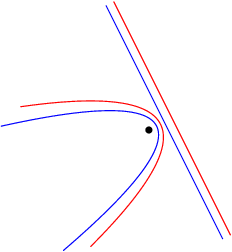

copeland
2013-02-21 20:43:11
What parabolas intersect the parabola with directrix y=2x+3?
What parabolas intersect the parabola with directrix y=2x+3?
copeland
2013-02-21 20:44:44
What about when the slope is -2?
What about when the slope is -2?
nuggetfan
2013-02-21 20:45:38
yes, all
yes, all
kli2000
2013-02-21 20:45:38
yes
yes
ninjataco
2013-02-21 20:45:38
yes, they will intersect.
yes, they will intersect.
roilior
2013-02-21 20:45:38
you forgot to post their answers
you forgot to post their answers
VietaFan
2013-02-21 20:45:38
2 hits
2 hits
copeland
2013-02-21 20:45:54
Yes, those all intersect because they point a different direction.
Yes, those all intersect because they point a different direction.
copeland
2013-02-21 20:45:56
Every directrix with slope −2, −1, or 1 gives a parabola that intersects twice. There are 6⋅4=24 such parabolas giving 48 intersections.
Every directrix with slope −2, −1, or 1 gives a parabola that intersects twice. There are 6⋅4=24 such parabolas giving 48 intersections.
copeland
2013-02-21 20:46:07
What about when a=2?
What about when a=2?
copeland
2013-02-21 20:46:24
What values of b give us an intersection with the parabola defined by y=2x+3?
What values of b give us an intersection with the parabola defined by y=2x+3?
sammyMaX
2013-02-21 20:46:36
you forgot to list a=0
you forgot to list a=0
copeland
2013-02-21 20:46:43
Right, thank you.
Right, thank you.
copeland
2013-02-21 20:46:49
We'll correct the count at the end.
We'll correct the count at the end.
VietaFan
2013-02-21 20:47:16
All parabolas with directrix slope != 2 and y = 2x+k where k <= -3
All parabolas with directrix slope != 2 and y = 2x+k where k <= -3
piguy314
2013-02-21 20:47:16
All except when b is 1 or 2?
All except when b is 1 or 2?
number.sense
2013-02-21 20:47:16
-1, -2, and -3 are the y intercepts of directrices of those parabolas
-1, -2, and -3 are the y intercepts of directrices of those parabolas
program4
2013-02-21 20:47:16
those with b negative
those with b negative
kli2000
2013-02-21 20:47:16
-1, -2, -3
-1, -2, -3
piguy314
2013-02-21 20:47:16
-1,-2,-3
-1,-2,-3
ParallelProcess
2013-02-21 20:47:16
it has to be on the other side of the focus, so b<0
it has to be on the other side of the focus, so b<0
program4
2013-02-21 20:47:16
b=-3, -2, -1
b=-3, -2, -1
copeland
2013-02-21 20:47:19
If the slope of the directrix is 2, then we get either 2 or 0 intersections. We get 2 intersections from those directrices on the opposite side of F=(0,0). We can determine this by the y-intercepts.
If the slope of the directrix is 2, then we get either 2 or 0 intersections. We get 2 intersections from those directrices on the opposite side of F=(0,0). We can determine this by the y-intercepts.
copeland
2013-02-21 20:47:25
The directrices 2x−3, 2x−2, and 2x−1 each give two more intersections and the directrices 2x+1 and 2x+2 do not give parabolas that intersect the given parabola at all.
The directrices 2x−3, 2x−2, and 2x−1 each give two more intersections and the directrices 2x+1 and 2x+2 do not give parabolas that intersect the given parabola at all.
copeland
2013-02-21 20:47:59
This parabola has 48+6=54 intersections.
This parabola has 48+6=54 intersections.
copeland
2013-02-21 20:48:05
Generally, when do two parabolas fail to intersect?
Generally, when do two parabolas fail to intersect?
Voytek
2013-02-21 20:48:41
When their directrices are parallel and they are facing the same side
When their directrices are parallel and they are facing the same side
ic1999
2013-02-21 20:48:41
when they have parallel directrices and they are facing the same direction
when they have parallel directrices and they are facing the same direction
program4
2013-02-21 20:48:41
same a, same sign of b
same a, same sign of b
kli2000
2013-02-21 20:48:41
when slopes are the same, and (0, 0) is not inbeween the lines
when slopes are the same, and (0, 0) is not inbeween the lines
VietaFan
2013-02-21 20:48:41
When there are parallel directrixes on the same side of the origin.
When there are parallel directrixes on the same side of the origin.
mcdonalds106_7
2013-02-21 20:48:41
iff directrices have same slope and are on same side of focus
iff directrices have same slope and are on same side of focus
copeland
2013-02-21 20:48:45
A pair of parabolas will only fail to intersect when their directrices have the same slope and the y-intercepts have the same sign.
A pair of parabolas will only fail to intersect when their directrices have the same slope and the y-intercepts have the same sign.
copeland
2013-02-21 20:48:48
So how many total intersections are there?
So how many total intersections are there?
FrozenFury
2013-02-21 20:50:28
810
810
number.sense
2013-02-21 20:50:28
60 overcounts
60 overcounts
mcdonalds106_7
2013-02-21 20:50:28


ksun48
2013-02-21 20:50:28
I mean 870 - 60 = 810
I mean 870 - 60 = 810
kli2000
2013-02-21 20:50:28
(has to be a multiple of 54)
(has to be a multiple of 54)
VietaFan
2013-02-21 20:50:28
54*30/2 or 810 (C)
54*30/2 or 810 (C)
roilior
2013-02-21 20:50:28
810
810
program4
2013-02-21 20:50:28
810
810
copeland
2013-02-21 20:50:31
There are 30⋅272intersecting pairs and each pair intersects twice, so the total number of intersections is 30⋅27=810. (C)
There are 30⋅272intersecting pairs and each pair intersects twice, so the total number of intersections is 30⋅27=810. (C)
copeland
2013-02-21 20:50:34
Alternatively, you could just draw all 30 parabolas and count:
Alternatively, you could just draw all 30 parabolas and count:
copeland
2013-02-21 20:50:39
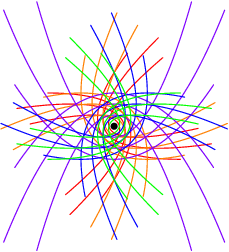

matholympiad25
2013-02-21 20:51:04
WHOA how could we count that...
WHOA how could we count that...
copeland
2013-02-21 20:51:05
Come on. There are only 810 intersections there. . . .
Come on. There are only 810 intersections there. . . .
copeland
2013-02-21 20:51:13
I get the feeling that this was pretty hard for a 21.
I get the feeling that this was pretty hard for a 21.
copeland
2013-02-21 20:51:44
Next problem. Back to the world of algebra.
Next problem. Back to the world of algebra.
copeland
2013-02-21 20:51:48


copeland
2013-02-21 20:51:56
(I bet it's probably not 272. . . .)
(I bet it's probably not 272. . . .)
copeland
2013-02-21 20:52:04
And ew. Logs.
And ew. Logs.
copeland
2013-02-21 20:52:09
And logs with different bases, which are hard to work with.
And logs with different bases, which are hard to work with.
copeland
2013-02-21 20:52:12
What could make them easier to work with?
What could make them easier to work with?
sparkles257
2013-02-21 20:52:38
base change?
base change?
Voytek
2013-02-21 20:52:38
Use change of base
Use change of base
mrwoodpusher
2013-02-21 20:52:38
change of base
change of base
esque
2013-02-21 20:52:38
change of base formula
change of base formula
Jayjayliu
2013-02-21 20:52:38
make them the smae base
make them the smae base
hamup1
2013-02-21 20:52:38
Change bases! Or exponents
Change bases! Or exponents
djmathman
2013-02-21 20:52:38
Change of base!
Change of base!
mapletree14
2013-02-21 20:52:38
change of base
change of base
mssmath
2013-02-21 20:52:38
Log rules/ change of base
Log rules/ change of base
copeland
2013-02-21 20:52:42
Logs are usually easier to work with if they have the same base.
Logs are usually easier to work with if they have the same base.
copeland
2013-02-21 20:52:47
So let's convert everything to the same base.
So let's convert everything to the same base.
copeland
2013-02-21 20:52:55
Let's leave the base undecided for now. We'll just write "log" for our new log with the yet-to-be decided base. (You can use base 10 if you feel happier that way.)
Let's leave the base undecided for now. We'll just write "log" for our new log with the yet-to-be decided base. (You can use base 10 if you feel happier that way.)
copeland
2013-02-21 20:53:03
What is lognx as a log in our new base?
What is lognx as a log in our new base?
ic1999
2013-02-21 20:53:24
logx/logn
logx/logn
Voytek
2013-02-21 20:53:24
logx/logn
logx/logn
UrInvalid
2013-02-21 20:53:24
log x/ logn
log x/ logn
nuggetfan
2013-02-21 20:53:24
logx/logn
logx/logn
RexT95
2013-02-21 20:53:24
log x / log n
log x / log n
RelaxationUtopia
2013-02-21 20:53:24
logx/logn
logx/logn
toodles9
2013-02-21 20:53:24
logx/logn
logx/logn
piguy314
2013-02-21 20:53:24
log(x)/log(n)
log(x)/log(n)
theone142857
2013-02-21 20:53:24
log x/log n
log x/log n
kdokmeci
2013-02-21 20:53:24
logx/logn
logx/logn
copeland
2013-02-21 20:53:28
lognx=logxlogn.
lognx=logxlogn.
copeland
2013-02-21 20:53:31
Similarly,
logmx=logxlogm.
Similarly,
logmx=logxlogm.
copeland
2013-02-21 20:53:34
Now our equation is:
8(logxlogn)(logxlogm)−7(logxlogn)−6(logxlogm)−2013=0.
Now our equation is:
8(logxlogn)(logxlogm)−7(logxlogn)−6(logxlogm)−2013=0.
copeland
2013-02-21 20:53:37
Why is this nicer?
Why is this nicer?
thecmd999
2013-02-21 20:54:46
it's a quadratic in log x!
it's a quadratic in log x!
matholympiad25
2013-02-21 20:54:46
Quadratic in log x
Quadratic in log x
mathman500
2013-02-21 20:54:46
Quadratic in logx
Quadratic in logx
UrInvalid
2013-02-21 20:54:46
looks like quadratic equation
looks like quadratic equation
axwscedv
2013-02-21 20:54:46
quadratic
quadratic
copeland
2013-02-21 20:54:49
Because it's a quadratic in log x!
Because it's a quadratic in log x!
copeland
2013-02-21 20:54:53
In fact, let's set y=logx to make it look nicer.
In fact, let's set y=logx to make it look nicer.
copeland
2013-02-21 20:54:56
We can also set a=logm and b=logn to make it look even nicer still!
We can also set a=logm and b=logn to make it look even nicer still!
copeland
2013-02-21 20:54:59
Now our equation is just
8aby2−(6a+7b)y−2013=0.
Now our equation is just
8aby2−(6a+7b)y−2013=0.
copeland
2013-02-21 20:55:05
What are we trying to do?
What are we trying to do?
centralbs
2013-02-21 20:55:43
we want product of x's
we want product of x's
nuggetfan
2013-02-21 20:55:43
find smallest product
find smallest product
RelaxationUtopia
2013-02-21 20:55:43
minimize prodct of solutions
minimize prodct of solutions
swe1
2013-02-21 20:55:43
find m and n so that products of solutions is smallest?
find m and n so that products of solutions is smallest?
copeland
2013-02-21 20:55:49
We want the product of the x's in the original equation to be as small a positive integer as possible. What does that mean for the y's?
We want the product of the x's in the original equation to be as small a positive integer as possible. What does that mean for the y's?
mcdonalds106_7
2013-02-21 20:56:24
smallest sum for y's
smallest sum for y's
OCed
2013-02-21 20:56:24
We need the sum of the y's
We need the sum of the y's
ic1999
2013-02-21 20:56:24
smallest sum
smallest sum
delta1
2013-02-21 20:56:24
make the sum smallest
make the sum smallest
number.sense
2013-02-21 20:56:24
minimize product of solutions --> mnimize sum of roots of this quadratic
minimize product of solutions --> mnimize sum of roots of this quadratic
ParallelProcess
2013-02-21 20:56:24
sum of ys should be smallest
sum of ys should be smallest
suparnoghoshal100
2013-02-21 20:56:24
summation of the ys
summation of the ys
copeland
2013-02-21 20:56:33
Remember, y=logx. So if x1 and x2 are the roots of the original equation, and y1=logx1 and y2=logx2.
Remember, y=logx. So if x1 and x2 are the roots of the original equation, and y1=logx1 and y2=logx2.
copeland
2013-02-21 20:56:37
We see that logx1x2=logx1+logx2=y1+y2.
We see that logx1x2=logx1+logx2=y1+y2.
copeland
2013-02-21 20:56:41
So, to examine the product of the x's, we examine the sum of the y's.
So, to examine the product of the x's, we examine the sum of the y's.
copeland
2013-02-21 20:56:43
But what is the sum of the y's?
But what is the sum of the y's?
ic1999
2013-02-21 20:57:29
vieta's formulas: (6/1 + 7/b)/(8/ab)
vieta's formulas: (6/1 + 7/b)/(8/ab)
evanyao10
2013-02-21 20:57:29
6/a + 7/b all over 8/ab
6/a + 7/b all over 8/ab
program4
2013-02-21 20:57:29
6a+7b8ab
6a+7b8ab
Imsacred
2013-02-21 20:57:29
(6/a+7/b)/(8/ab)
(6/a+7/b)/(8/ab)
DaChickenInc
2013-02-21 20:57:29


mathwizard888
2013-02-21 20:57:29
(6/a+7/b)/(8/(ab))
(6/a+7/b)/(8/(ab))
distortedwalrus
2013-02-21 20:57:29
(6/a+7/b)/(8/ab)
(6/a+7/b)/(8/ab)
copeland
2013-02-21 20:57:33
The sum of the roots of our quadratic is
6a+7b8ab.
The sum of the roots of our quadratic is
6a+7b8ab.
copeland
2013-02-21 20:57:37
This can be simplified by multiplying numerator and denominator by ab:
6b+7a8=78a+34b.
This can be simplified by multiplying numerator and denominator by ab:
6b+7a8=78a+34b.
copeland
2013-02-21 20:57:41
And recall that this equals logx1x2, where x1 and x2 are the root of the original equation.
And recall that this equals logx1x2, where x1 and x2 are the root of the original equation.
copeland
2013-02-21 20:57:51
So what?
So what?
copeland
2013-02-21 20:58:40
I don't know much about a and b. . . .
I don't know much about a and b. . . .
copeland
2013-02-21 20:58:51
Let's remember what a and b are! They're the logs of m and n.
Let's remember what a and b are! They're the logs of m and n.
copeland
2013-02-21 20:59:21
This gives us
logx1x2=78logm+34logn.
This gives us
logx1x2=78logm+34logn.
copeland
2013-02-21 20:59:30
Now what?
Now what?
number.sense
2013-02-21 20:59:52
raise 10 to the power of this
raise 10 to the power of this
Voytek
2013-02-21 20:59:52
Combine using log rules
Combine using log rules
centralbs
2013-02-21 20:59:52
use rule of logs to write the constant as exponents
use rule of logs to write the constant as exponents
ic1999
2013-02-21 20:59:52
log(m^(7/8)n^(3/4))
log(m^(7/8)n^(3/4))
nuggetfan
2013-02-21 20:59:52
power rule?
power rule?
delta1
2013-02-21 20:59:52
unlog
unlog
copeland
2013-02-21 20:59:54
This gives us
logx1x2=78logm+34logn.
This gives us
logx1x2=78logm+34logn.
copeland
2013-02-21 20:59:57
But we can simplify that right side!
But we can simplify that right side!
copeland
2013-02-21 21:00:01
We get
logx1x2=log(m7/8n3/4).
We get
logx1x2=log(m7/8n3/4).
copeland
2013-02-21 21:00:07
That tells us that x1x2=m7/8n3/4.
That tells us that x1x2=m7/8n3/4.
copeland
2013-02-21 21:00:15
Great. m and n are the integers that we control in the problem. We want to minimize x1x2, assuming that it, also, is an integer.
Great. m and n are the integers that we control in the problem. We want to minimize x1x2, assuming that it, also, is an integer.
copeland
2013-02-21 21:00:20
How do we make this as small a positive integer as possible?
How do we make this as small a positive integer as possible?
copeland
2013-02-21 21:01:15
We can write it as
x1x2=8√m7n6,
does that help?
We can write it as
x1x2=8√m7n6,
does that help?
centralbs
2013-02-21 21:01:34
try powers of 2
try powers of 2
mcdonalds106_7
2013-02-21 21:01:34
m and n are powers of 2
m and n are powers of 2
ksun48
2013-02-21 21:01:34
m and n being powers of 2
m and n being powers of 2
copeland
2013-02-21 21:01:43
We need m7n6 to be as small an 8th power as possible.
We need m7n6 to be as small an 8th power as possible.
copeland
2013-02-21 21:01:46
But also remember that m and n themselves are positive integers greater than 1.
But also remember that m and n themselves are positive integers greater than 1.
copeland
2013-02-21 21:01:51
We should make m and n both powers of 2. (Throwing in any extra prime factors will just make it larger.) We want to make m7n6=28z for some positive z.
We should make m and n both powers of 2. (Throwing in any extra prime factors will just make it larger.) We want to make m7n6=28z for some positive z.
copeland
2013-02-21 21:01:55
If m=2p and n=2q, what is this equivalent to?
If m=2p and n=2q, what is this equivalent to?
swe1
2013-02-21 21:02:40
7p+6q=8z
7p+6q=8z
evanyao10
2013-02-21 21:02:40
7p + 6q = 8z
7p + 6q = 8z
nuggetfan
2013-02-21 21:02:40
7p + 6q = 8z
7p + 6q = 8z
matholympiad25
2013-02-21 21:02:40
7p+6q=8z
7p+6q=8z
flyrain
2013-02-21 21:02:40
6p+6q=8z
6p+6q=8z
kdokmeci
2013-02-21 21:02:40
7p+6q=8z
7p+6q=8z
copeland
2013-02-21 21:02:44
We have to solve 7p+6q=8z for the smallest possible z.
We have to solve 7p+6q=8z for the smallest possible z.
copeland
2013-02-21 21:02:46
What the smallest solution?
What the smallest solution?
program4
2013-02-21 21:03:27
z=4 (p=2, q=3)
z=4 (p=2, q=3)
bharatputra
2013-02-21 21:03:27
(p, q) (2, 3)
(p, q) (2, 3)
colinhy
2013-02-21 21:03:27
p = 2 q = 3
p = 2 q = 3
ParallelProcess
2013-02-21 21:03:27
m = 2^2 and n =2^3?
m = 2^2 and n =2^3?
mathmaster2012
2013-02-21 21:03:27
p=2,q=3,z=4
p=2,q=3,z=4
colinhy
2013-02-21 21:03:27
p = 2 q = 3 z = 4
p = 2 q = 3 z = 4
copeland
2013-02-21 21:03:30
It's 7(2)+6(3)=32. (You can easily check that we can solve for z<4.)
It's 7(2)+6(3)=32. (You can easily check that we can solve for z<4.)
copeland
2013-02-21 21:03:32
And what's the answer to our problem?
And what's the answer to our problem?
sammyMaX
2013-02-21 21:04:11
12
12
bookie331
2013-02-21 21:04:11
2^2 + 2^3 = 12
2^2 + 2^3 = 12
ksun48
2013-02-21 21:04:11
4+8=12
4+8=12
distortedwalrus
2013-02-21 21:04:11
(A) 12
(A) 12
planetpeter91
2013-02-21 21:04:11
A,12
A,12
mathwizard888
2013-02-21 21:04:11
8+4=12 (A)
8+4=12 (A)
mydogcanpur
2013-02-21 21:04:11
12 (A)
12 (A)
piguy314
2013-02-21 21:04:11
4+8=12 (A)
4+8=12 (A)
VietaFan
2013-02-21 21:04:11
2^3+2^2 = 12(A)
2^3+2^2 = 12(A)
flyrain
2013-02-21 21:04:11
12 A hey...
12 A hey...
copeland
2013-02-21 21:04:15
We find m=22=4 and n=23=8 produces a product of x's of 32, and that's the smallest possible.
We find m=22=4 and n=23=8 produces a product of x's of 32, and that's the smallest possible.
copeland
2013-02-21 21:04:18
The answer is 4+8=12. Answer (A).
The answer is 4+8=12. Answer (A).
copeland
2013-02-21 21:04:24
Good job.
Good job.
copeland
2013-02-21 21:04:40
Problem 23 on the 10B was the same as that digits problem (Problem 25) from the 12B, so we've handled that one already.
Problem 23 on the 10B was the same as that digits problem (Problem 25) from the 12B, so we've handled that one already.
copeland
2013-02-21 21:04:51
7 down, 2 to go!
7 down, 2 to go!
copeland
2013-02-21 21:04:54


copeland
2013-02-21 21:05:01
Let's start by sketching a picture. I've labeled the known lengths and known angles given by the data in the problem.
Let's start by sketching a picture. I've labeled the known lengths and known angles given by the data in the problem.
copeland
2013-02-21 21:05:06
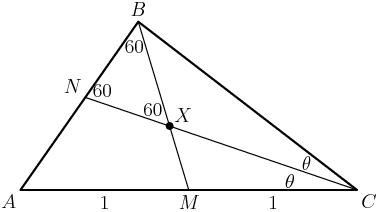

copeland
2013-02-21 21:05:13
As you can tell, BNX is perfectly equilateral.
As you can tell, BNX is perfectly equilateral.
copeland
2013-02-21 21:05:25
What game do we play with this one?
What game do we play with this one?
flyrain
2013-02-21 21:05:59
angle chasing
angle chasing
distortedwalrus
2013-02-21 21:05:59
angle chasing
angle chasing
VietaFan
2013-02-21 21:05:59
Angle chasing
Angle chasing
mydogcanpur
2013-02-21 21:05:59
Angle chasing
Angle chasing
misgiven
2013-02-21 21:05:59
angle chase?
angle chase?
copeland
2013-02-21 21:06:05
That's actually a great idea here.
That's actually a great idea here.
copeland
2013-02-21 21:06:18
We have a lot of 60s, so it might turn out fine.
We have a lot of 60s, so it might turn out fine.
copeland
2013-02-21 21:06:22
I'll save you the trouble:
I'll save you the trouble:
copeland
2013-02-21 21:06:27
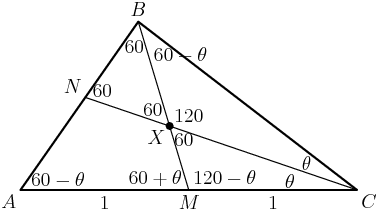

copeland
2013-02-21 21:06:29
Notice anything?
Notice anything?
mrwoodpusher
2013-02-21 21:07:38
similar triangles?
similar triangles?
ssilwa
2013-02-21 21:07:38
similar triangles!
similar triangles!
copeland
2013-02-21 21:07:40
Where?
Where?
giratina150
2013-02-21 21:08:05
BCM~ACB
BCM~ACB
colinhy
2013-02-21 21:08:05
CBM = CAB
CBM = CAB
sammyMaX
2013-02-21 21:08:05
ABC is similar to BCM
ABC is similar to BCM
UrInvalid
2013-02-21 21:08:05
ABC and BMC
ABC and BMC
copeland
2013-02-21 21:08:08
ABC and BMC are similar!
ABC and BMC are similar!
copeland
2013-02-21 21:08:14


copeland
2013-02-21 21:08:20
So?
So?
ssilwa
2013-02-21 21:08:41
we can set up ratios
we can set up ratios
kdokmeci
2013-02-21 21:08:41
Find proportions
Find proportions
kli2000
2013-02-21 21:08:41
ratios of side lengths
ratios of side lengths
copeland
2013-02-21 21:08:53
Let x be the side length BC.
Let x be the side length BC.
copeland
2013-02-21 21:08:57
What is x?
What is x?
kli2000
2013-02-21 21:09:30
x = √2
x = √2
ic1999
2013-02-21 21:09:30
sqrt2
sqrt2
nuggetfan
2013-02-21 21:09:30
1/x = x/2
1/x = x/2
colinhy
2013-02-21 21:09:30
sqrt2
sqrt2
nuggetfan
2013-02-21 21:09:30
x = sqrt(2)
x = sqrt(2)
sieb11
2013-02-21 21:09:30
sqrt(2)
sqrt(2)
copeland
2013-02-21 21:09:34
Then we have ACBC=BCMC, so 2x=x1, so x=√2.
Then we have ACBC=BCMC, so 2x=x1, so x=√2.
copeland
2013-02-21 21:09:40
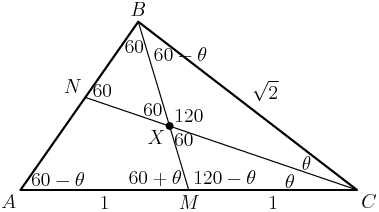

copeland
2013-02-21 21:09:45
Any other similar triangles?
Any other similar triangles?
DaChickenInc
2013-02-21 21:10:16


kdokmeci
2013-02-21 21:10:16
BNC~MXC
BNC~MXC
DaChickenInc
2013-02-21 21:10:16


RexT95
2013-02-21 21:10:16
bxc and xmc
bxc and xmc
piguy314
2013-02-21 21:10:16
BNC and MXC
BNC and MXC
OCed
2013-02-21 21:10:16
XMC, BNC
XMC, BNC
Cradin
2013-02-21 21:10:16
XMC and BNC
XMC and BNC
henrikjb
2013-02-21 21:10:16
BNC ~ MXC
BNC ~ MXC
guilt
2013-02-21 21:10:16
bxc and anc
bxc and anc
piguy314
2013-02-21 21:10:16
BNC and MXC
BNC and MXC
Voytek
2013-02-21 21:10:16
BNC and XMC
BNC and XMC
copeland
2013-02-21 21:10:19
BNC and MXC are similar!
BNC and MXC are similar!
copeland
2013-02-21 21:10:26


copeland
2013-02-21 21:10:28
And we know BCMC=√2, so
BNMX=NCXC=√2
as well. Which ratio looks more useful?
And we know BCMC=√2, so
BNMX=NCXC=√2
as well. Which ratio looks more useful?
VietaFan
2013-02-21 21:11:48
Nc/XC
Nc/XC
ksun48
2013-02-21 21:11:48
I guess NC/XC
I guess NC/XC
UrInvalid
2013-02-21 21:11:48
NC/XC
NC/XC
flyrain
2013-02-21 21:11:48
NC/XC
NC/XC
misgiven
2013-02-21 21:11:48
NC/XC
NC/XC
thedealer1994
2013-02-21 21:11:48
NC/XC = √2
NC/XC = √2
copeland
2013-02-21 21:11:51
MX doesn't look all that useful. But NC/XC looks useful, because NC=XC+NX, and NX is what we want.
MX doesn't look all that useful. But NC/XC looks useful, because NC=XC+NX, and NX is what we want.
copeland
2013-02-21 21:11:55
In fact, let's set t=BN=BX=NX. What equation do we have for t?
In fact, let's set t=BN=BX=NX. What equation do we have for t?
bharatputra
2013-02-21 21:13:20
XCsqrt2=XC+t
XCsqrt2=XC+t
VietaFan
2013-02-21 21:13:20
XC+t=sqrt{2}XC; t=sqrt(2)-1XC
XC+t=sqrt{2}XC; t=sqrt(2)-1XC
nuggetfan
2013-02-21 21:13:20
t+XC/XC = sqrt(2)
t+XC/XC = sqrt(2)
VietaFan
2013-02-21 21:13:20
t=√2−1(XC)
t=√2−1(XC)
thedealer1994
2013-02-21 21:13:20
t/XC=√2−1
t/XC=√2−1
kli2000
2013-02-21 21:13:20
t/MX = (t+XC)/XC = sqrt2
t/MX = (t+XC)/XC = sqrt2
copeland
2013-02-21 21:13:23


copeland
2013-02-21 21:13:27
But that means
XC=t√2−1=t(√2+1)(√2−1)(√2+1)=t(√2+1).
But that means
XC=t√2−1=t(√2+1)(√2−1)(√2+1)=t(√2+1).
copeland
2013-02-21 21:13:38
Here are our lengths:
Here are our lengths:
copeland
2013-02-21 21:13:40
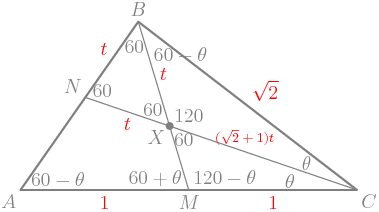

copeland
2013-02-21 21:13:43
Now what?
Now what?
ksun48
2013-02-21 21:14:24
I guess the only think we can do is LOC then
I guess the only think we can do is LOC then
mprashker
2013-02-21 21:14:24
law of cosines?
law of cosines?
thedealer1994
2013-02-21 21:14:24
Law of cosines!
Law of cosines!
giratina150
2013-02-21 21:14:24
law of cosines
law of cosines
Cradin
2013-02-21 21:14:24
law of cosines
law of cosines
distortedwalrus
2013-02-21 21:14:24
use the law of cosines
use the law of cosines
Voytek
2013-02-21 21:14:24
Law of cosines
Law of cosines
copeland
2013-02-21 21:14:29
On what?
On what?
mydogcanpur
2013-02-21 21:15:08
on triangle BXC
on triangle BXC
theone142857
2013-02-21 21:15:08
BXC
BXC
kdokmeci
2013-02-21 21:15:08
BXC
BXC
OCed
2013-02-21 21:15:08
BXC
BXC
VietaFan
2013-02-21 21:15:08
on BXC
on BXC
bookie331
2013-02-21 21:15:08
bxc?
bxc?
fireonice18
2013-02-21 21:15:08
on triangle bxc to find BN
on triangle bxc to find BN
copeland
2013-02-21 21:15:14
We can use the Law of Cosines on BXC.
We can use the Law of Cosines on BXC.
copeland
2013-02-21 21:15:17
(BC)2=(BX)2+(XC)2−2(BX)(XC)cos∠BXC.
(BC)2=(BX)2+(XC)2−2(BX)(XC)cos∠BXC.
copeland
2013-02-21 21:15:22
This gives
2=t2+((√2+1)t)2−2t(√2+1)tcos(120).
This gives
2=t2+((√2+1)t)2−2t(√2+1)tcos(120).
copeland
2013-02-21 21:15:26
But cos(120)=−12, so this is
2=t2(1+(√2+1)2+(√2+1)).
But cos(120)=−12, so this is
2=t2(1+(√2+1)2+(√2+1)).
copeland
2013-02-21 21:15:38
I'm not going to torture you by asking you to solve that.
I'm not going to torture you by asking you to solve that.
copeland
2013-02-21 21:15:41
This simplifies to
2=t2(1+(3+2√2)+(1+√2))=t2(5+3√2).
This simplifies to
2=t2(1+(3+2√2)+(1+√2))=t2(5+3√2).
copeland
2013-02-21 21:15:49
Hence,
t2=25+3√2=2(5−3√2)(5+3√2)(5−3√2)=10−6√225−18=10−6√27,
answer (A).
Hence,
t2=25+3√2=2(5−3√2)(5+3√2)(5−3√2)=10−6√225−18=10−6√27,
answer (A).
kdokmeci
2013-02-21 21:16:05
Whew!
Whew!
copeland
2013-02-21 21:16:07
Whew.
Whew.
sparkles257
2013-02-21 21:16:17
whoa...
whoa...
Archimedes10
2013-02-21 21:16:17
What. Just. Happened.
What. Just. Happened.
copeland
2013-02-21 21:16:24
Aritmhmetic.
Aritmhmetic.
copeland
2013-02-21 21:16:40
Angle chase -> Law of Cosines -> radical manipulating -> Profit.
Angle chase -> Law of Cosines -> radical manipulating -> Profit.
Voytek
2013-02-21 21:16:59
You mean arithmetic?
You mean arithmetic?
copeland
2013-02-21 21:17:08
One man's arithmetic is another man's radical manipulation.
One man's arithmetic is another man's radical manipulation.
copeland
2013-02-21 21:17:39
I feel like such a subversive when I radically manipulate.
I feel like such a subversive when I radically manipulate.
copeland
2013-02-21 21:17:51
OK, one more problem.
OK, one more problem.
Archimedes10
2013-02-21 21:18:07
You mean, one man's Aritmhmetic is another man's radical manipulation.
You mean, one man's Aritmhmetic is another man's radical manipulation.
copeland
2013-02-21 21:18:11
Yes. Gesundheit.
Yes. Gesundheit.
matholympiad25
2013-02-21 21:19:00
What does gesundheit mean?
What does gesundheit mean?
minimario
2013-02-21 21:19:00
Gesundheit?
Gesundheit?
sparkles257
2013-02-21 21:19:00
whats a gesundheit?
whats a gesundheit?
copeland
2013-02-21 21:19:02
It's German for "Don't sneeze on me."
It's German for "Don't sneeze on me."
copeland
2013-02-21 21:19:05


copeland
2013-02-21 21:19:14
OK, great!
OK, great!
copeland
2013-02-21 21:19:16
Polynomials.
Polynomials.
copeland
2013-02-21 21:19:21
I like polynomials.
I like polynomials.
copeland
2013-02-21 21:19:22
What do we know about the roots?
What do we know about the roots?
kdokmeci
2013-02-21 21:19:53
Conjugates!
Conjugates!
mapletree14
2013-02-21 21:19:53
they occur in conjugate pairs
they occur in conjugate pairs
giratina150
2013-02-21 21:19:53
complex conjugate?
complex conjugate?
kdokmeci
2013-02-21 21:19:53
They are complex and conjugates!
They are complex and conjugates!
ic1999
2013-02-21 21:19:53
conjugates of each other
conjugates of each other
noobynoob
2013-02-21 21:19:53
conjugates
conjugates
copeland
2013-02-21 21:19:55
Always?
Always?
program4
2013-02-21 21:20:31
the complex roots are in conjugates
the complex roots are in conjugates
ksun48
2013-02-21 21:20:31
unless real
unless real
ic1999
2013-02-21 21:20:31
unless b is 0
unless b is 0
centralbs
2013-02-21 21:20:31
as long as b is not 0
as long as b is not 0
nuggetfan
2013-02-21 21:20:31
unless b = 0
unless b = 0
theone142857
2013-02-21 21:20:31
unless b=0
unless b=0
copeland
2013-02-21 21:20:41
Right. Don't forget the possibility of real roots.
Right. Don't forget the possibility of real roots.
copeland
2013-02-21 21:20:44
The real roots are all integers.
The real roots are all integers.
copeland
2013-02-21 21:20:47
The non-real roots come in conjugate pairs, a±bi.
The non-real roots come in conjugate pairs, a±bi.
copeland
2013-02-21 21:20:51
Therefore we can factor P as a product of linear pieces, (z+r), and a product of pairs of non-real linear terms,(z−(a−bi))(z−(a+bi)).
Therefore we can factor P as a product of linear pieces, (z+r), and a product of pairs of non-real linear terms,(z−(a−bi))(z−(a+bi)).
copeland
2013-02-21 21:20:56
What do we get when we expand such a quadratic?
What do we get when we expand such a quadratic?
program4
2013-02-21 21:21:50
z2−2az+(a2+b2)
z2−2az+(a2+b2)
alphaReally
2013-02-21 21:21:50
z^2-2za+a^2+b^2
z^2-2za+a^2+b^2
Archimedes10
2013-02-21 21:21:50
This is a difference of two squares factored
This is a difference of two squares factored
mapletree14
2013-02-21 21:21:50


mssmath
2013-02-21 21:21:50
z^2-2z-a^2+b^2
z^2-2z-a^2+b^2
matholympiad25
2013-02-21 21:21:50
z^2-2a+(a^2+b^2)
z^2-2a+(a^2+b^2)
thedealer1994
2013-02-21 21:21:50
(z−a)2+b2
(z−a)2+b2
VietaFan
2013-02-21 21:21:50
z2−2az+a2+b2
z2−2az+a2+b2
copeland
2013-02-21 21:21:54
(z−(a−bi))(z−(a+bi))=z2−2az+(a2+b2).
(z−(a−bi))(z−(a+bi))=z2−2az+(a2+b2).
copeland
2013-02-21 21:22:03
Now we can factor P as a product of pieces of the form z+r with r an integer and pieces of the form
z2−2az+(a2+b2),
where a and b are integers.
Now we can factor P as a product of pieces of the form z+r with r an integer and pieces of the form
z2−2az+(a2+b2),
where a and b are integers.
copeland
2013-02-21 21:22:11
When we factor P into linear terms and quadratic terms with nonreal roots (we'll call such factors "irreducibles"), that determines a factorization of 50.
When we factor P into linear terms and quadratic terms with nonreal roots (we'll call such factors "irreducibles"), that determines a factorization of 50.
copeland
2013-02-21 21:22:26
Make sure you understand that statement. One example is the factorization(z−5)(z−2)(z2+1)(z2+z+5), with 2 irreducible linear factors and 2 irreducible quadratic factors.
Make sure you understand that statement. One example is the factorization(z−5)(z−2)(z2+1)(z2+z+5), with 2 irreducible linear factors and 2 irreducible quadratic factors.
copeland
2013-02-21 21:22:33
How should we organize our solution?
How should we organize our solution?
Doink
2013-02-21 21:23:37
they are all distinct and all multiply to either 50 or -50
they are all distinct and all multiply to either 50 or -50
ic1999
2013-02-21 21:23:37
use vieta's and factor 50
use vieta's and factor 50
kdokmeci
2013-02-21 21:23:37
Cases of factors of 50
Cases of factors of 50
Voytek
2013-02-21 21:23:37
By the different factors of 50
By the different factors of 50
nuggetfan
2013-02-21 21:23:37
factorize 50?
factorize 50?
1ph0ne
2013-02-21 21:23:37
Casework?
Casework?
copeland
2013-02-21 21:23:43
We can solve this problem via casework on all possible factorizations of 50. All we have to do is count the ways to multiply all such polynomials together to get a constant term of +50.
We can solve this problem via casework on all possible factorizations of 50. All we have to do is count the ways to multiply all such polynomials together to get a constant term of +50.
copeland
2013-02-21 21:23:54
Let's look at all irreducibles with particular constant terms. The list of factors of 50 is −50,−25,−10,−5,−2,−1,1,2,5,10,25,50.
Let's look at all irreducibles with particular constant terms. The list of factors of 50 is −50,−25,−10,−5,−2,−1,1,2,5,10,25,50.
copeland
2013-02-21 21:24:01
What are all irreducible polynomials with constant term −50?
What are all irreducible polynomials with constant term −50?
theone142857
2013-02-21 21:24:50
(x-50)
(x-50)
nuggetfan
2013-02-21 21:24:50
x-50
x-50
ic1999
2013-02-21 21:24:50
x-50 and that's it
x-50 and that's it
copeland
2013-02-21 21:24:54
Since z2−2az+(a2+b2) has a nonnegative constant term, the only possible polynomial is the linear one, x−50.
Since z2−2az+(a2+b2) has a nonnegative constant term, the only possible polynomial is the linear one, x−50.
copeland
2013-02-21 21:24:57
What about irreducibles with constant term −25?
What about irreducibles with constant term −25?
kz190
2013-02-21 21:25:16
x-25
x-25
program4
2013-02-21 21:25:16
just x-25
just x-25
Doink
2013-02-21 21:25:16
x-25
x-25
mathwizard888
2013-02-21 21:25:16
x-25
x-25
ABCDE
2013-02-21 21:25:16
x-25
x-25
mydogcanpur
2013-02-21 21:25:16
x-25
x-25
lucylai
2013-02-21 21:25:16
x-25
x-25
Cradin
2013-02-21 21:25:16
x-25
x-25
copeland
2013-02-21 21:25:20
Again there are no quadratics, just the linear polynomial z−25.
Again there are no quadratics, just the linear polynomial z−25.
copeland
2013-02-21 21:25:25
In fact, we get one possible linear polynomial for each factor.
In fact, we get one possible linear polynomial for each factor.
copeland
2013-02-21 21:25:30
constant polynomial−50z−50−25z−25−10z−10−5z−5−2z−2−1z−11z+12z+25z+510z+1025z+2550z+50
constant polynomial−50z−50−25z−25−10z−10−5z−5−2z−2−1z−11z+12z+25z+510z+1025z+2550z+50
copeland
2013-02-21 21:25:38
Now let's find the quadratics.
Now let's find the quadratics.
copeland
2013-02-21 21:25:42
For a2+b2=1, what are all irreducibles z2−2az+(a2+b2)?
For a2+b2=1, what are all irreducibles z2−2az+(a2+b2)?
kdokmeci
2013-02-21 21:26:39
z^2+1
z^2+1
chenboy3
2013-02-21 21:26:39
z^2 + 1
z^2 + 1
theone142857
2013-02-21 21:26:39
z^2_+1
z^2_+1
ABCDE
2013-02-21 21:26:39
just x^2+1
just x^2+1
program4
2013-02-21 21:26:39
z^2+1
z^2+1
copeland
2013-02-21 21:26:41
If a=1 or a=−1 then b=0 and the roots are 1±0i, which are real. That gives z2±2z+1=(z±1)2. This is not irreducible. The only irreducible quadratic has a=0 and isz2+1.
If a=1 or a=−1 then b=0 and the roots are 1±0i, which are real. That gives z2±2z+1=(z±1)2. This is not irreducible. The only irreducible quadratic has a=0 and isz2+1.
copeland
2013-02-21 21:27:00
Does that make sense?
Does that make sense?
copeland
2013-02-21 21:27:11
We throw z2+2z+1 away because it factors.
We throw z2+2z+1 away because it factors.
copeland
2013-02-21 21:27:15
constant polynomials−50z−50−25z−25−10z−10−5z−5−2z−2−1z−11z+1, z2+12z+2, …5z+5, …10z+10, …25z+25, …50z+50, …
constant polynomials−50z−50−25z−25−10z−10−5z−5−2z−2−1z−11z+1, z2+12z+2, …5z+5, …10z+10, …25z+25, …50z+50, …
copeland
2013-02-21 21:28:11
What are all possible values of a when a=2 and z2−2az+(a2+b2) is irreducible?
What are all possible values of a when a=2 and z2−2az+(a2+b2) is irreducible?
copeland
2013-02-21 21:28:57
What can we choose for a if a2+b2=2?
What can we choose for a if a2+b2=2?
sammyMaX
2013-02-21 21:29:23
a=±1
a=±1
Cradin
2013-02-21 21:29:23
a = 1
a = 1
nuggetfan
2013-02-21 21:29:23
a = +- 1
a = +- 1
mikhailgromov
2013-02-21 21:29:23
1
1
Voytek
2013-02-21 21:29:23
1
1
mathwizard888
2013-02-21 21:29:23
1, -1
1, -1
distortedwalrus
2013-02-21 21:29:23
a=b=1
a=b=1
sparkles257
2013-02-21 21:29:23
1 or -1?
1 or -1?
program4
2013-02-21 21:29:23
a=-1, 1
a=-1, 1
copeland
2013-02-21 21:29:29
The only way to write 2 as a sum of squares is 2=1+1. Therefore a=±1.
The only way to write 2 as a sum of squares is 2=1+1. Therefore a=±1.
copeland
2013-02-21 21:29:34
constant polynomials−50z−50−25z−25−10z−10−5z−5−2z−2−1z−11(z+1), (z2+1)2(z+2), (z2±2z+2)5z+5, …10z+10, …25z+25, …50z+50, …
constant polynomials−50z−50−25z−25−10z−10−5z−5−2z−2−1z−11(z+1), (z2+1)2(z+2), (z2±2z+2)5z+5, …10z+10, …25z+25, …50z+50, …
copeland
2013-02-21 21:29:38
OK, I'm starting to see where this is going. What are the possible values for a when a2+b2=5?
OK, I'm starting to see where this is going. What are the possible values for a when a2+b2=5?
bharatputra
2013-02-21 21:30:20
-2,-1,1,2
-2,-1,1,2
nuggetfan
2013-02-21 21:30:20
+-2, +-1
+-2, +-1
program4
2013-02-21 21:30:20
a=1, 2, -1, -2
a=1, 2, -1, -2
Cradin
2013-02-21 21:30:20
a = +-2, +-1
a = +-2, +-1
linpaws
2013-02-21 21:30:20
-2,-1,1,2
-2,-1,1,2
VietaFan
2013-02-21 21:30:20
a = 1 or 2 or -1 or -2
a = 1 or 2 or -1 or -2
flyrain
2013-02-21 21:30:20
5=1+4
5=1+4
Imsacred
2013-02-21 21:30:20
+-1, +-2
+-1, +-2
copeland
2013-02-21 21:30:23
We can write 5=1+4 or 5=4+1. Therefore a=±1 or a=±2.
We can write 5=1+4 or 5=4+1. Therefore a=±1 or a=±2.
copeland
2013-02-21 21:30:27
constant polynomials−50z−50−25z−25−10z−10−5z−5−2z−2−1z−11(z+1), (z2+1)2(z+2), (z2±2z+2)5 z+5, (z2±2z+5), (z2±4z+5)10z+10, …25z+25, …50z+50, …
constant polynomials−50z−50−25z−25−10z−10−5z−5−2z−2−1z−11(z+1), (z2+1)2(z+2), (z2±2z+2)5 z+5, (z2±2z+5), (z2±4z+5)10z+10, …25z+25, …50z+50, …
copeland
2013-02-21 21:30:31
What are the possible values for a when a2+b2=10?
What are the possible values for a when a2+b2=10?
Cradin
2013-02-21 21:30:59
a = +/-3, +/- 1
a = +/-3, +/- 1
Imsacred
2013-02-21 21:30:59
+-1, +-3
+-1, +-3
ic1999
2013-02-21 21:30:59
+-1, +-3
+-1, +-3
kli2000
2013-02-21 21:30:59
+- 1, +-3
+- 1, +-3
mapletree14
2013-02-21 21:30:59
+-3, +-1
+-3, +-1
distortedwalrus
2013-02-21 21:30:59
+-1, +-2, +-3
+-1, +-2, +-3
aux770
2013-02-21 21:30:59
+-1,+-3
+-1,+-3
pi_Plus_45x23
2013-02-21 21:30:59
+-1,+-3
+-1,+-3
1ph0ne
2013-02-21 21:30:59
+- 3, +- 1
+- 3, +- 1
bookie331
2013-02-21 21:30:59
+-1, +-3
+-1, +-3
guilt
2013-02-21 21:31:05
a = +-1, +- 3
a = +-1, +- 3
copeland
2013-02-21 21:31:07
We can write 10=1+9=9+1, so a=±1 or a=±3.
We can write 10=1+9=9+1, so a=±1 or a=±3.
copeland
2013-02-21 21:31:11
constant polynomials−50z−50−25z−25−10z−10−5z−5−2z−2−1z−11(z+1), (z2+1)2(z+2), (z2±2z+2)5 z+5, (z2±2z+5), (z2±4z+5)10 z+10, (z2±2z+10), (z2±6z+10)25z+25, …50z+50, …
constant polynomials−50z−50−25z−25−10z−10−5z−5−2z−2−1z−11(z+1), (z2+1)2(z+2), (z2±2z+2)5 z+5, (z2±2z+5), (z2±4z+5)10 z+10, (z2±2z+10), (z2±6z+10)25z+25, …50z+50, …
copeland
2013-02-21 21:31:15
What are the possible values for a when a2+b2=25?
What are the possible values for a when a2+b2=25?
copeland
2013-02-21 21:31:58
There seems to be contention here.
There seems to be contention here.
copeland
2013-02-21 21:32:12
Specifically, we can't decide whether to inclued -5, 0, or 5.
Specifically, we can't decide whether to inclued -5, 0, or 5.
copeland
2013-02-21 21:32:20
What are the possible values of a?
What are the possible values of a?
mathwizard888
2013-02-21 21:33:16
-4, -3, 0, 3, 4
-4, -3, 0, 3, 4
program4
2013-02-21 21:33:16
3, 4, -3, -4, 0 (not 5 and -5 since those are not irreducible)
3, 4, -3, -4, 0 (not 5 and -5 since those are not irreducible)
program4
2013-02-21 21:33:16
3, 4, -3, -4, 0
3, 4, -3, -4, 0
sammyMaX
2013-02-21 21:33:16
we need some imaginary part, so a cannot equal 5 or -5
we need some imaginary part, so a cannot equal 5 or -5
Imsacred
2013-02-21 21:33:16
rather, we include 0, but not +-5 because we already counted both of them
rather, we include 0, but not +-5 because we already counted both of them
kdokmeci
2013-02-21 21:33:16
a doesnt have to be nonzero
a doesnt have to be nonzero
copeland
2013-02-21 21:33:20
We can write 25=9+16=16+9, so a=±3 or a=±4. Notice also that 25 is a square, so we could have a=0 as well.
We can write 25=9+16=16+9, so a=±3 or a=±4. Notice also that 25 is a square, so we could have a=0 as well.
copeland
2013-02-21 21:33:29
constant polynomials−50z−50−25z−25−10z−10−5z−5−2z−2−1z−11(z+1), (z2+1)2(z+2), (z2±2z+2)5 z+5, (z2±2z+5), (z2±4z+5)10 z+10, (z2±2z+10), (z2±6z+10)25 z+25, (z2+25), (z2±6z+25), (z2±8z+25)50z+50, …
constant polynomials−50z−50−25z−25−10z−10−5z−5−2z−2−1z−11(z+1), (z2+1)2(z+2), (z2±2z+2)5 z+5, (z2±2z+5), (z2±4z+5)10 z+10, (z2±2z+10), (z2±6z+10)25 z+25, (z2+25), (z2±6z+25), (z2±8z+25)50z+50, …
copeland
2013-02-21 21:33:44
And finally, what about 50?
And finally, what about 50?
Imsacred
2013-02-21 21:34:38
+-1, +-7, +-5
+-1, +-7, +-5
kdokmeci
2013-02-21 21:34:38
a=+-7,+-5,+-1
a=+-7,+-5,+-1
mathwizard888
2013-02-21 21:34:38
-7, -5, -1, 1, 5, 7
-7, -5, -1, 1, 5, 7
mydogcanpur
2013-02-21 21:34:38
a= +-1, +-5, +-7
a= +-1, +-5, +-7
matholympiad25
2013-02-21 21:34:38
+-1, +-7, +-5
+-1, +-7, +-5
darrench12
2013-02-21 21:34:38
+-5,+-7,+-1
+-5,+-7,+-1
program4
2013-02-21 21:34:38
1, 7, -1, -7, 5, -5
1, 7, -1, -7, 5, -5
sparkles257
2013-02-21 21:34:38
+-1, +-7, +- 5
+-1, +-7, +- 5
copeland
2013-02-21 21:34:43
Since 50=1+49=49+1 we could have a=±1 or a=±7. We can also write 5=25+25, so we get a=±5 as well.
Since 50=1+49=49+1 we could have a=±1 or a=±7. We can also write 5=25+25, so we get a=±5 as well.
copeland
2013-02-21 21:34:47
constant polynomials−50z−50−25z−25−10z−10−5z−5−2z−2−1z−11(z+1), (z2+1)2(z+2), (z2±2z+2)5 z+5, (z2±2z+5), (z2±4z+5)10 z+10, (z2±2z+10), (z2±6z+10)25 z+25, (z2+25), (z2±6z+25), (z2±8z+25)50 z+50, (z2±2z+50), (z2±5z+50), (z2±14z+50)
constant polynomials−50z−50−25z−25−10z−10−5z−5−2z−2−1z−11(z+1), (z2+1)2(z+2), (z2±2z+2)5 z+5, (z2±2z+5), (z2±4z+5)10 z+10, (z2±2z+10), (z2±6z+10)25 z+25, (z2+25), (z2±6z+25), (z2±8z+25)50 z+50, (z2±2z+50), (z2±5z+50), (z2±14z+50)
copeland
2013-02-21 21:34:51
constant polynomials number−50z−501−25z−251−10z−101−5z−51−2z−21−1z−111(z+1), (z2+1)22(z+2), (z2±2z+2)35 z+5, (z2±2z+5), (z2±4z+5)510 z+10, (z2±2z+10), (z2±6z+10)525 z+25, (z2+25), (z2±6z+25), (z2±8z+25)650 z+50, (z2±2z+50), (z2±5z+50), (z2±14z+50) 7
constant polynomials number−50z−501−25z−251−10z−101−5z−51−2z−21−1z−111(z+1), (z2+1)22(z+2), (z2±2z+2)35 z+5, (z2±2z+5), (z2±4z+5)510 z+10, (z2±2z+10), (z2±6z+10)525 z+25, (z2+25), (z2±6z+25), (z2±8z+25)650 z+50, (z2±2z+50), (z2±5z+50), (z2±14z+50) 7
copeland
2013-02-21 21:35:01
That's all the polynomials. Now we just need to count all the ways to multiply things in the middle column such that the product of the constant terms is 50.
That's all the polynomials. Now we just need to count all the ways to multiply things in the middle column such that the product of the constant terms is 50.
copeland
2013-02-21 21:35:11
I have a serious phobia of signs and casework, and it looks like we've got a lot of those to take care of up there. Is there a way we can streamline our casework to avoid dealing with signs in our factorization? Tell me something that will make those worries go away.
I have a serious phobia of signs and casework, and it looks like we've got a lot of those to take care of up there. Is there a way we can streamline our casework to avoid dealing with signs in our factorization? Tell me something that will make those worries go away.
copeland
2013-02-21 21:36:48
Is there any way to flip the sign of the constant term?
Is there any way to flip the sign of the constant term?
Imsacred
2013-02-21 21:38:17
we can choose whether or not to have a root of +1 so we dont have to worry about the resulting sign of the rest
we can choose whether or not to have a root of +1 so we dont have to worry about the resulting sign of the rest
mydogcanpur
2013-02-21 21:38:17
Multiply by -1?
Multiply by -1?
mikhailgromov
2013-02-21 21:38:17
Multiply by ;−1
Multiply by ;−1
sammyMaX
2013-02-21 21:38:17
Use the (z-1) to flip signs
Use the (z-1) to flip signs
copeland
2013-02-21 21:38:22
We have the linear polynomial z−1. If we find all polynomials with constant term ±50 while ignoring this polynomial, then we can multiply by z−1 in the end to fix all those polynomials that have constant term −50.
We have the linear polynomial z−1. If we find all polynomials with constant term ±50 while ignoring this polynomial, then we can multiply by z−1 in the end to fix all those polynomials that have constant term −50.
copeland
2013-02-21 21:38:32
While we're cleaning things up, what other constant should we discuss and why?
While we're cleaning things up, what other constant should we discuss and why?
kdokmeci
2013-02-21 21:39:47
1?
1?
sammyMaX
2013-02-21 21:39:47
(z+1). It doesn't contribute anything, so each polynomial we can either add it or not add it
(z+1). It doesn't contribute anything, so each polynomial we can either add it or not add it
centralbs
2013-02-21 21:39:47
z+1
z+1
VietaFan
2013-02-21 21:39:47
The 1. It can go over and over and not change the product.
The 1. It can go over and over and not change the product.
sammyMaX
2013-02-21 21:39:47
same with (z2+1)
same with (z2+1)
kdokmeci
2013-02-21 21:39:52


copeland
2013-02-21 21:39:53
We can multiply a polynomial by z+1 or z2+1 and not change the constant term. Therefore we can ignore these two possible factors, too, and then multiply by 22=4 at the end based on whether these two appear or not.
We can multiply a polynomial by z+1 or z2+1 and not change the constant term. Therefore we can ignore these two possible factors, too, and then multiply by 22=4 at the end based on whether these two appear or not.
copeland
2013-02-21 21:40:00
Now we've dramatically simplified our table:
Now we've dramatically simplified our table:
copeland
2013-02-21 21:40:03
constant polynomials number±2(z−2), (z+2), (z2±2z+2)4±5(z−5), z+5, (z2±2z+5), (z2±4z+5)6±10(z−10), (z+10), (z2±2z+10), (z2±6z+10)6±25(z−25), (z+25), (z2+25), (z2±6z+25), (z2±8z+25)7±50 (z−50), (z+50), (z2±2z+50), (z2±5z+50), (z2±14z+50) 8
constant polynomials number±2(z−2), (z+2), (z2±2z+2)4±5(z−5), z+5, (z2±2z+5), (z2±4z+5)6±10(z−10), (z+10), (z2±2z+10), (z2±6z+10)6±25(z−25), (z+25), (z2+25), (z2±6z+25), (z2±8z+25)7±50 (z−50), (z+50), (z2±2z+50), (z2±5z+50), (z2±14z+50) 8
copeland
2013-02-21 21:40:06
Now we count! What are all the factorizations of 50 (with positive factors)?
Now we count! What are all the factorizations of 50 (with positive factors)?
copeland
2013-02-21 21:41:33
Factorizations!
Factorizations!
copeland
2013-02-21 21:41:47
We want to write 50 as a product of some number of numbers, each of which is greater than 1.
We want to write 50 as a product of some number of numbers, each of which is greater than 1.
Imsacred
2013-02-21 21:42:30
2*5*5, 10*5, 2*25, 50
2*5*5, 10*5, 2*25, 50
lucylai
2013-02-21 21:42:30
50, 2*25, 5*10, 2*5*5
50, 2*25, 5*10, 2*5*5
linpaws
2013-02-21 21:42:30
2x5x5,2x25,5x10
2x5x5,2x25,5x10
kdokmeci
2013-02-21 21:42:30


Imsacred
2013-02-21 21:42:30
2*5*5, 2*25, 10*5, 50
2*5*5, 2*25, 10*5, 50
kli2000
2013-02-21 21:42:30
2*5*5, 5*10, 2*25, 50
2*5*5, 5*10, 2*25, 50
UrInvalid
2013-02-21 21:42:30
50,2*25,5*10,2*5*5
50,2*25,5*10,2*5*5
copeland
2013-02-21 21:42:33
50=50=2⋅25=5⋅10=2⋅5⋅5.
50=50=2⋅25=5⋅10=2⋅5⋅5.
copeland
2013-02-21 21:42:38
How many polynomials correspond to the trivial factorization of ±50?
How many polynomials correspond to the trivial factorization of ±50?
UrInvalid
2013-02-21 21:43:20
8
8
Imsacred
2013-02-21 21:43:20
8
8
Iggy Iguana
2013-02-21 21:43:20
8
8
sammyMaX
2013-02-21 21:43:20
8
8
lucylai
2013-02-21 21:43:20
8
8
joshxiong
2013-02-21 21:43:20
8
8
UrInvalid
2013-02-21 21:43:20
8 polynomials
8 polynomials
copeland
2013-02-21 21:43:21
There are 8 polynomials. (Later we will get a total of 32 when we include (z+1) and (z2+1).
There are 8 polynomials. (Later we will get a total of 32 when we include (z+1) and (z2+1).
copeland
2013-02-21 21:43:25
factorization 50 2⋅25 5⋅10 2⋅5⋅5count8
factorization 50 2⋅25 5⋅10 2⋅5⋅5count8
copeland
2013-02-21 21:43:28
How many polynomials correspond to the factorization 50=2⋅25?
How many polynomials correspond to the factorization 50=2⋅25?
OCed
2013-02-21 21:43:51
28
28
UrInvalid
2013-02-21 21:43:51
28
28
mssmath
2013-02-21 21:43:51
28
28
bharatputra
2013-02-21 21:43:51
28
28
Iggy Iguana
2013-02-21 21:43:51
28
28
pi_Plus_45x23
2013-02-21 21:43:51
28
28
mathwizard888
2013-02-21 21:43:51
28
28
copeland
2013-02-21 21:43:55
We pick one factor of constant 2 and one factor of constant 25, giving 4⋅7=28 polynomials.
We pick one factor of constant 2 and one factor of constant 25, giving 4⋅7=28 polynomials.
copeland
2013-02-21 21:43:58
factorization 50 2⋅25 5⋅10 2⋅5⋅5count84⋅7
factorization 50 2⋅25 5⋅10 2⋅5⋅5count84⋅7
copeland
2013-02-21 21:44:01
What about 5⋅10?
What about 5⋅10?
mathwizard888
2013-02-21 21:44:32
36
36
bharatputra
2013-02-21 21:44:32
36
36
Imsacred
2013-02-21 21:44:32
36
36
UrInvalid
2013-02-21 21:44:32
6*6=36
6*6=36
VietaFan
2013-02-21 21:44:32
36
36
mssmath
2013-02-21 21:44:32
36
36
dsrndm
2013-02-21 21:44:32
36
36
numbertheorist17
2013-02-21 21:44:32
36
36
copeland
2013-02-21 21:44:36
factorization 50 2⋅25 5⋅10 2⋅5⋅5count84⋅76⋅6
factorization 50 2⋅25 5⋅10 2⋅5⋅5count84⋅76⋅6
copeland
2013-02-21 21:44:39
And finally, 2⋅5⋅5?
And finally, 2⋅5⋅5?
mathwizard888
2013-02-21 21:45:19
4*6C2=60
4*6C2=60
Iggy Iguana
2013-02-21 21:45:19
60
60
OCed
2013-02-21 21:45:19
15*4=60
15*4=60
numbertheorist17
2013-02-21 21:45:19
60
60
sammyMaX
2013-02-21 21:45:19
60
60
copeland
2013-02-21 21:45:43
Here we have to pick one of the 4 polynomials in the 2-row and two from the 5-row giving 4(62)=4⋅15.
Here we have to pick one of the 4 polynomials in the 2-row and two from the 5-row giving 4(62)=4⋅15.
copeland
2013-02-21 21:45:55
factorization 50 2⋅25 5⋅10 2⋅5⋅5count84⋅76⋅64⋅15
factorization 50 2⋅25 5⋅10 2⋅5⋅5count84⋅76⋅64⋅15
copeland
2013-02-21 21:45:58
So what's the answer?
So what's the answer?
numbertheorist17
2013-02-21 21:47:11
total: 4(8+28+36+60)=4(132)=528 B
total: 4(8+28+36+60)=4(132)=528 B
Voytek
2013-02-21 21:47:11
B) 528
B) 528
mssmath
2013-02-21 21:47:11
(B)
(B)
bharatputra
2013-02-21 21:47:11
132*4=528 (b)
132*4=528 (b)
sparkles257
2013-02-21 21:47:11
B
B
kdokmeci
2013-02-21 21:47:11
A 288
A 288
Iggy Iguana
2013-02-21 21:47:11
528
528
danzhi
2013-02-21 21:47:11
528
528
kz190
2013-02-21 21:47:11
i got b
i got b
lucylai
2013-02-21 21:47:11
528
528
Imsacred
2013-02-21 21:47:11
4(8+28+36+60)=528 B
4(8+28+36+60)=528 B
theone142857
2013-02-21 21:47:11
528
528
pi_Plus_45x23
2013-02-21 21:47:11
B. 528
B. 528
mathwizard888
2013-02-21 21:47:11
528 (B)
528 (B)
mydogcanpur
2013-02-21 21:47:11
528 (B)
528 (B)
Math99
2013-02-21 21:47:11
c.
c.
copeland
2013-02-21 21:47:16
Here we have counted 8+4⋅7+6⋅6+4⋅15=132 total polynomials. Then we multiply by 2 to account for the presence or absence of z+1, and multiply by 2 again to handle z2+1.
Here we have counted 8+4⋅7+6⋅6+4⋅15=132 total polynomials. Then we multiply by 2 to account for the presence or absence of z+1, and multiply by 2 again to handle z2+1.
copeland
2013-02-21 21:47:23
The final count is 4⋅132=528. The answer is (B).
The final count is 4⋅132=528. The answer is (B).
copeland
2013-02-21 21:47:50
Good work. This problem was cool, except I got the wrong answer about 5 times before finally getting my arithmetic right.
Good work. This problem was cool, except I got the wrong answer about 5 times before finally getting my arithmetic right.
copeland
2013-02-21 21:48:13
I spent 10 minutes tracking down my error in 8+4⋅7+6⋅6+4⋅15=102
I spent 10 minutes tracking down my error in 8+4⋅7+6⋅6+4⋅15=102
VietaFan
2013-02-21 21:48:34
Thanks for doing this class; it was interesting.
Thanks for doing this class; it was interesting.
copeland
2013-02-21 21:48:37
Thank you guys.
Thank you guys.
copeland
2013-02-21 21:48:42
Oh, there was a good question above:
Oh, there was a good question above:
sammyMaX
2013-02-21 21:48:46
what if they didn't specify it had n roots? would it make the problem more complicated?
what if they didn't specify it had n roots? would it make the problem more complicated?
copeland
2013-02-21 21:48:55
What happens when you allow repeated roots here?
What happens when you allow repeated roots here?
Iggy Iguana
2013-02-21 21:49:26
you can use a lot of 1's
you can use a lot of 1's
program4
2013-02-21 21:49:26
the answer would be infinity
the answer would be infinity
OCed
2013-02-21 21:49:26
You can have an infinite amount of polynomials.
You can have an infinite amount of polynomials.
matholympiad25
2013-02-21 21:49:26
Then you can get infinitely many (z+1)^k in the factors
Then you can get infinitely many (z+1)^k in the factors
bharatputra
2013-02-21 21:49:26
answer would be infinity
answer would be infinity
program4
2013-02-21 21:49:26
because x+1 can be used as many times as you want
because x+1 can be used as many times as you want
sammyMaX
2013-02-21 21:49:26
You could keep adding the 1's and -1
You could keep adding the 1's and -1
colinhy
2013-02-21 21:49:26
You could have infinitely mant (x+1)s
You could have infinitely mant (x+1)s
Imsacred
2013-02-21 21:49:26
you could have infinite roots of -1 or 1
you could have infinite roots of -1 or 1
copeland
2013-02-21 21:49:37
Right. That's the only point of forcing the roots to be distinct.
Right. That's the only point of forcing the roots to be distinct.
copeland
2013-02-21 21:50:21
Alright, I'm starting to wane here, and we're done with the last 5 of each test.
Alright, I'm starting to wane here, and we're done with the last 5 of each test.
copeland
2013-02-21 21:50:29
So. . .
So. . .
copeland
2013-02-21 21:50:30
That's all for tonight's Math Jam!
That's all for tonight's Math Jam!
mprashker
2013-02-21 21:50:32
Thank you very much. Will Richard Rusczyk make the videos again? those are very helpful.
Thank you very much. Will Richard Rusczyk make the videos again? those are very helpful.
copeland
2013-02-21 21:50:43
Yes. He plans to think about starting them next week.
Yes. He plans to think about starting them next week.
copeland
2013-02-21 21:51:09
Please join us again on Saturday, March 16, when we will discuss the AIME I contest.
Please join us again on Saturday, March 16, when we will discuss the AIME I contest.
1ph0ne
2013-02-21 21:51:24
Where can we find the transcript for this math jam?
Where can we find the transcript for this math jam?
copeland
2013-02-21 21:51:33
You can find the Math Jam transcript here:
You can find the Math Jam transcript here:
copeland
2013-02-21 21:51:41
once I post it.
once I post it.
kli2000
2013-02-21 21:52:24
what are the AIME math jams like?
what are the AIME math jams like?
copeland
2013-02-21 21:52:29
Like this, with AIME problems.
Like this, with AIME problems.
copeland
2013-02-21 21:52:38
We'll do all 15 and it will take a little over 3 hours.
We'll do all 15 and it will take a little over 3 hours.
Royalreter1
2013-02-21 21:52:42
Will the transcript be everything from the beginning?
Will the transcript be everything from the beginning?
copeland
2013-02-21 21:52:43
Yes.
Yes.
kdokmeci
2013-02-21 21:53:42
There weren't any circle problems in the final five (involving pi and stuff)
There weren't any circle problems in the final five (involving pi and stuff)
hamup1
2013-02-21 21:53:42
So we can attend the AIME math jams even if we don't get into the AIME contest right?
So we can attend the AIME math jams even if we don't get into the AIME contest right?
copeland
2013-02-21 21:53:46
Absolutely.
Absolutely.
trophies
2013-02-21 21:54:16
wait what day is the AIME on
wait what day is the AIME on
copeland
2013-02-21 21:54:22
March 14 and April 3.
March 14 and April 3.
ic1999
2013-02-21 21:55:04
pi day!!!!!
pi day!!!!!
crastybow
2013-02-21 21:55:04
March 14 is Pi Day! And it happens to be my birthday XD
March 14 is Pi Day! And it happens to be my birthday XD
djmathman
2013-02-21 21:56:27
And MIT Admissions Day!
And MIT Admissions Day!
mapletree14
2013-02-21 21:56:27
and when MIT RD results come out. . .
and when MIT RD results come out. . .
SteinsChaos
2013-02-21 21:56:27
and it happens to be MIT results day
and it happens to be MIT results day
copeland
2013-02-21 21:56:28
Funny thing for many of you to have on your minds. . . .
Funny thing for many of you to have on your minds. . . .
copeland
2013-02-21 21:57:29
Alright, I'm going home. Everyone have a good night!
Alright, I'm going home. Everyone have a good night!
Copyright © 2025 AoPS Incorporated. This page is copyrighted material. You can view and print this page for your own use, but you cannot share the contents of this file with others.









